Do you say lasagne or lasagna? Welllll whatever you call it, it’s one of those dishes that feels like a hug in food form. Everyone has their version, but this one is a classic chicken lasagna with a rich tomato sauce and creamy béchamel and is the kind you slow-cook on a Sunday afternoon, letting all the flavors mingle until it’s bubbling and golden.
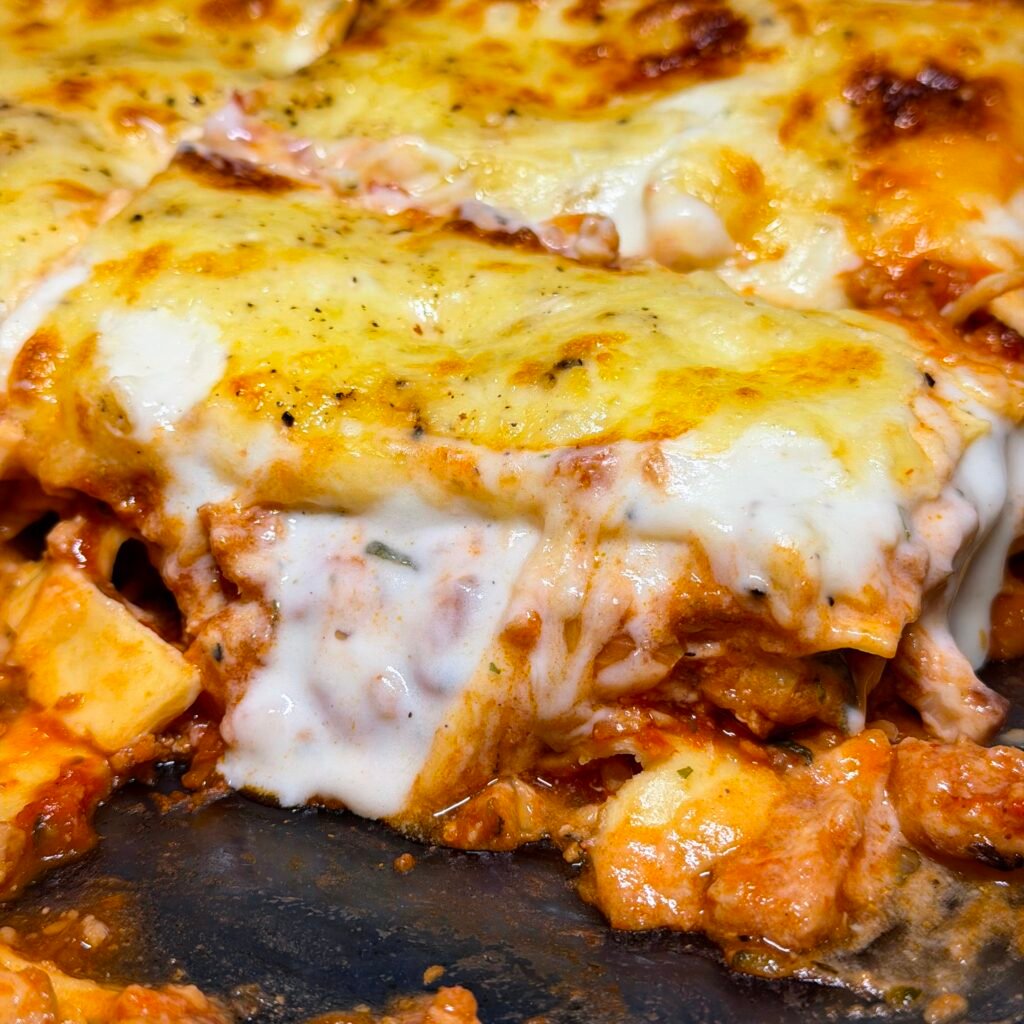
Now, if you know me, you know I’m all about shortcuts (and yes, I have a shortcut lasagna recipe too), but this one isn’t that. This is the slow, layered, deeply flavourful kind. It’s simple in ingredients but big on comfort — the kind that fills your home with that unmistakable, cozy lasagna smell. And of course, I’ll share a few shortcut tips along the way if you’re in a rush.
Ingredients You’ll Need
For the Chicken Tomato Sauce
- 2–3 tbsp olive oil
- 750g chicken mince
- 1 bay leaf
- 2 white onions, diced
- 2 medium carrots, diced
- 1 whole bulb of garlic, finely chopped
- 1½ tsp chilli flakes
- ½ tsp thyme
- 1 tsp oregano
- 1 zucchini, grated (optional – adds moisture and a sneaky veggie boost!)
- ½ cup red wine or 1 cup chicken broth
- 1 tbsp tomato paste
- 400g passata
- 400g canned peeled tomatoes
- Water as needed (rinse out the cans to get every bit of tomato goodness)
- Salt, to taste
For the Béchamel Sauce
- 3 tbsp butter
- ¼ cup flour
- 1L whole milk (3% fat)
- 90g herbed cream cheese (optional but adds so much creaminess)
- Salt & pepper, to taste
For Assembly
- Fresh or dried lasagna sheets
- Shredded mozzarella or cheese blend (for topping)
Step-by-Step: How to Make Chicken Lasagna
1. Make the Chicken Tomato Sauce
This is the heart of your lasagna — rich, flavorful, and full of texture.
Step 1: Heat 2–3 tablespoons of olive oil in a large, deep skillet or saucepan over medium heat.
Once the oil is hot, add the chicken mince. Spread it out evenly in the pan and sprinkle with a bit of salt. Resist the urge to stir immediately! Let it sit for a few minutes so it browns and caramelizes on the bottom — that’s where a lot of the flavor develops.
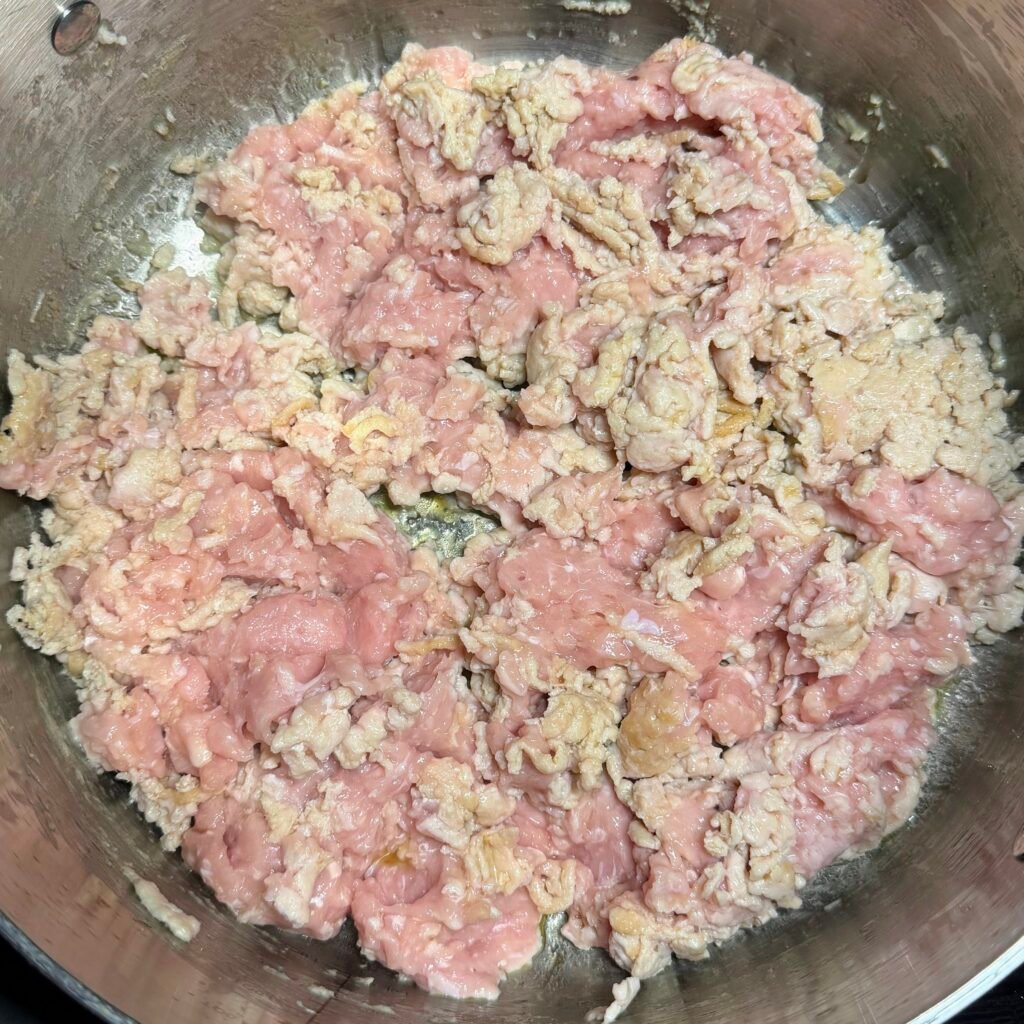
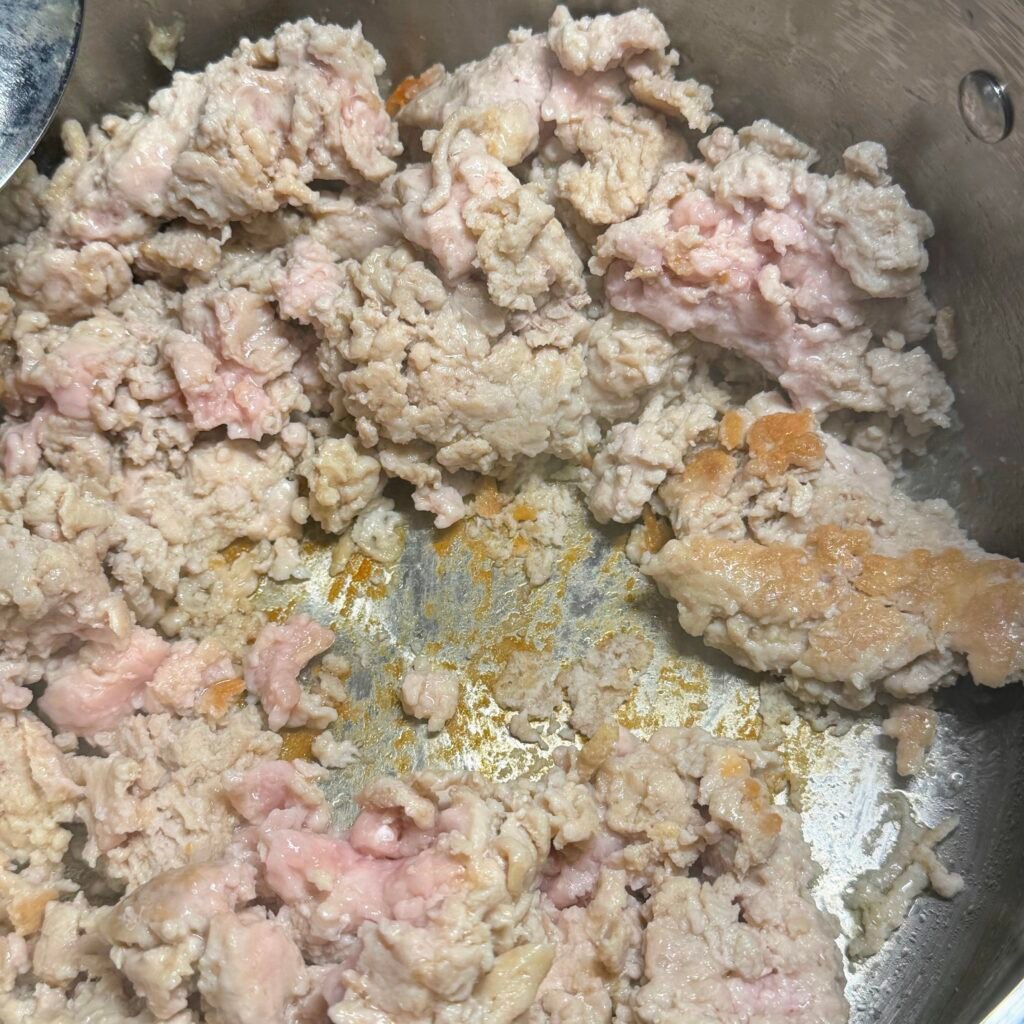
Step 2: Once the bottom looks golden and you start to smell that toasty aroma, use a wooden spoon to break the mince into smaller pieces.
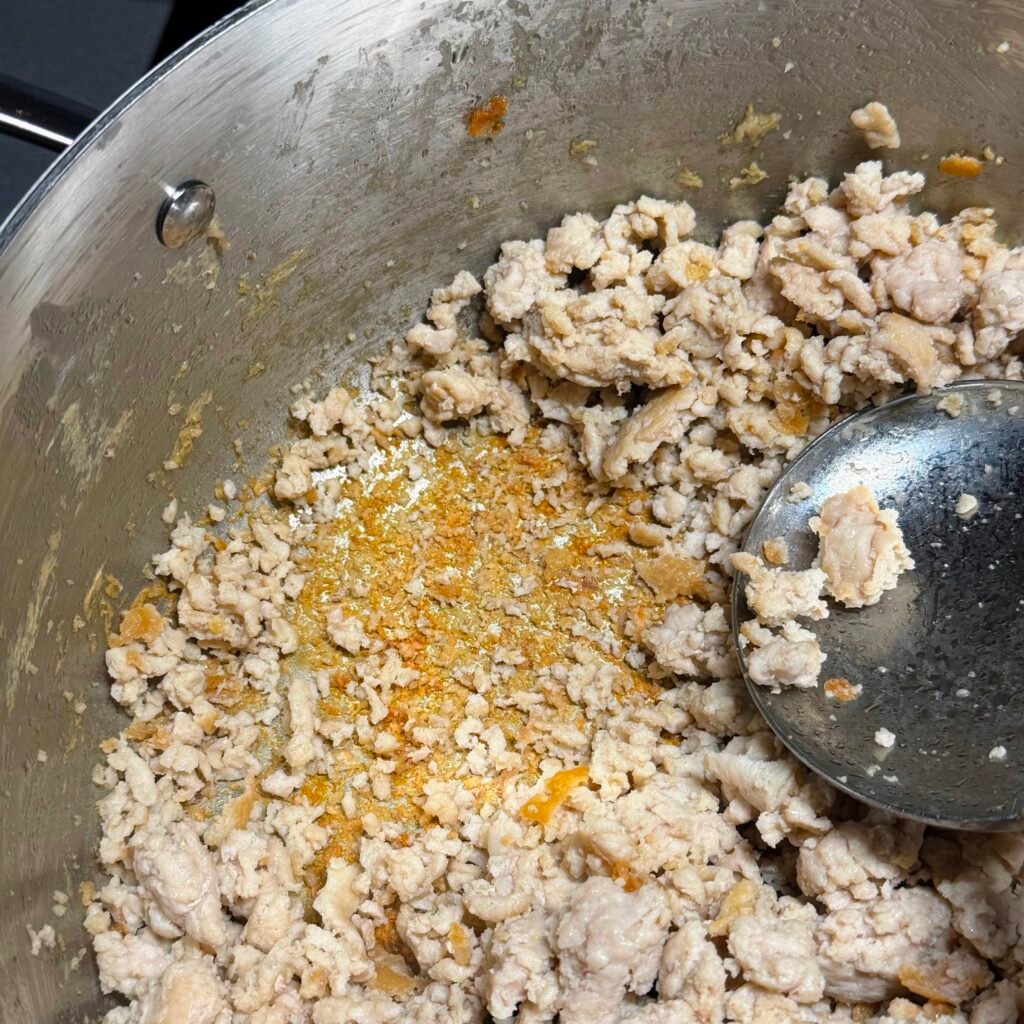
Step 3: Add the diced onions, carrots, bay leaf, and chopped garlic. Mix well, then cover the pan and let everything soften together for about 10–15 minutes on low heat. The vegetables will release moisture, which helps to deglaze the pan naturally.
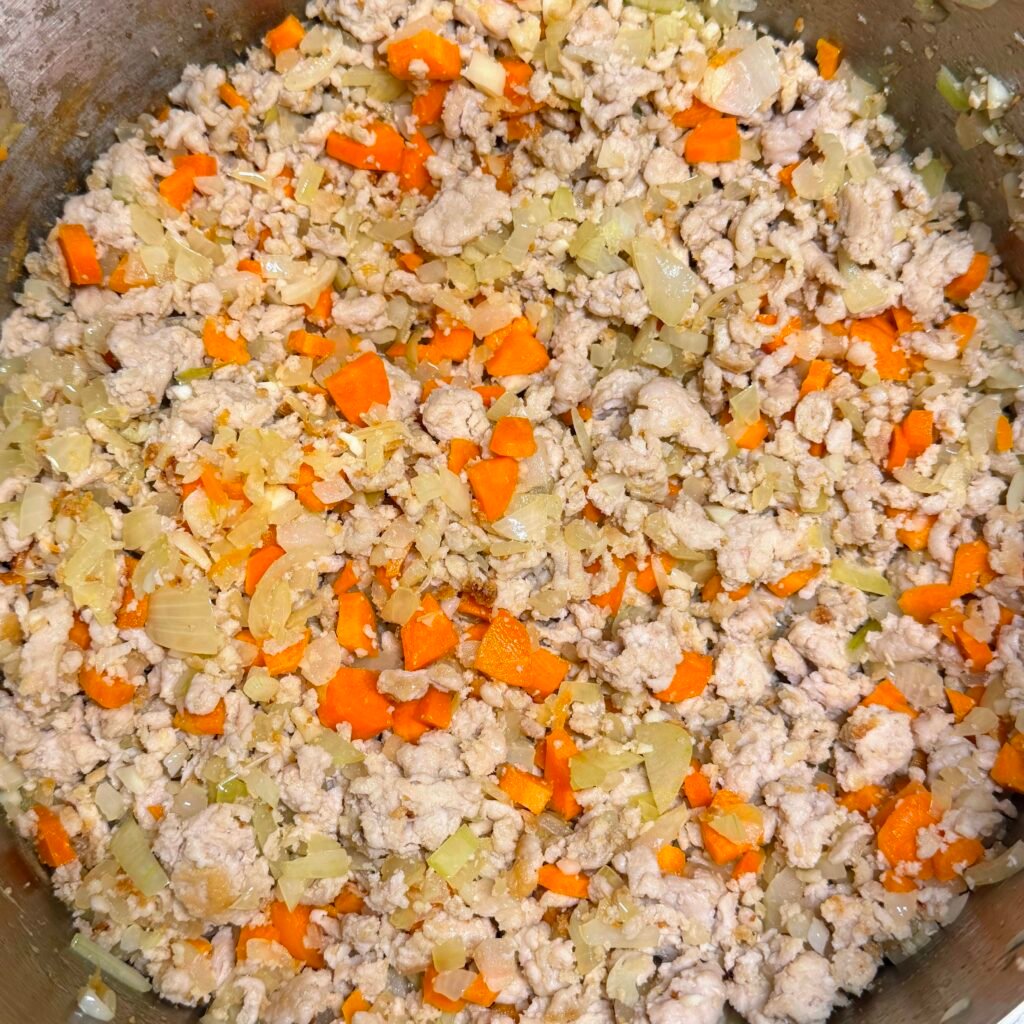
Step 4: Sprinkle in the chilli flakes, thyme, and oregano. Stir to coat everything evenly. Cover again and cook for another 5–7 minutes to let the herbs infuse the sauce base.
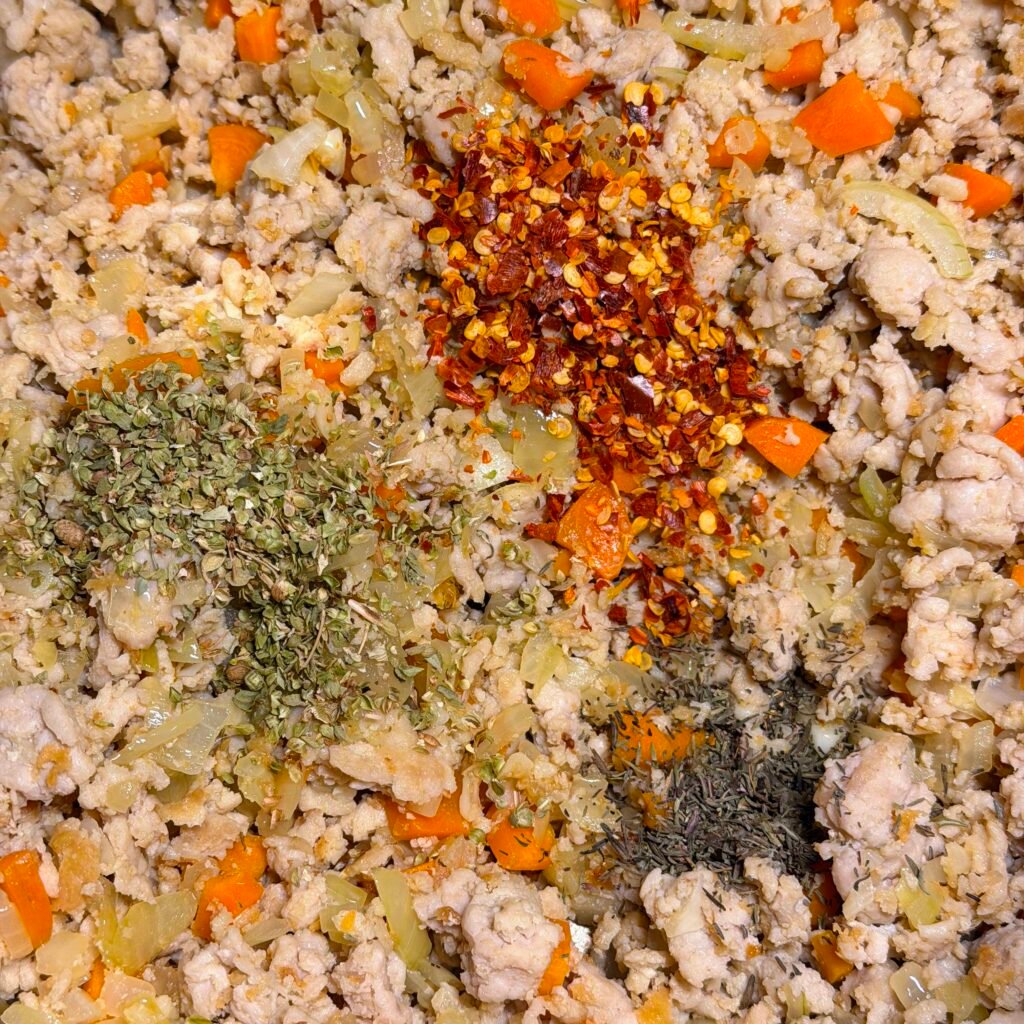
Step 5: If using zucchini, add it now. Grated zucchini adds moisture and a subtle sweetness that balances the acidity of the tomatoes. Increase the heat slightly to cook off any excess liquid and get a bit of light caramelization.
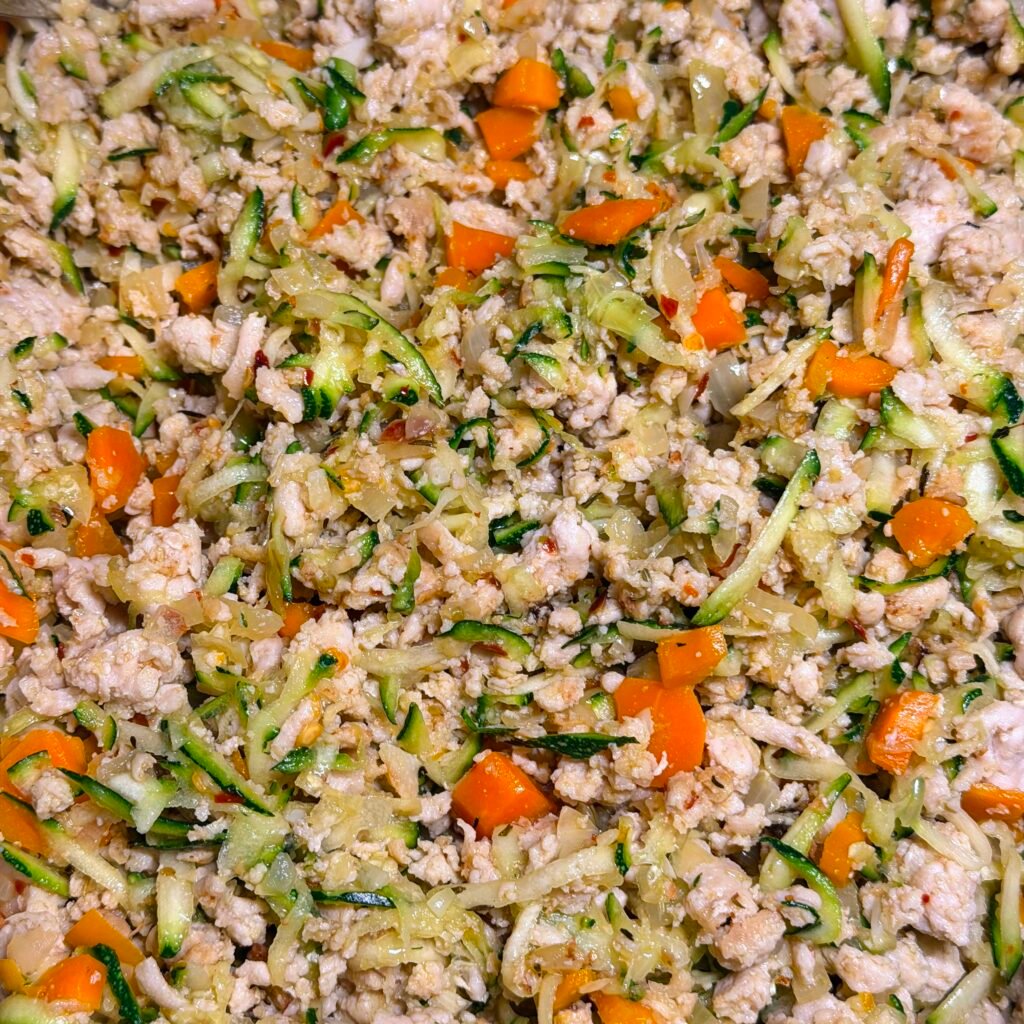
Step 6: Deglaze the pan by pouring in the red wine (or chicken broth if you prefer not to use alcohol). Stir and scrape up all those delicious brown bits stuck to the bottom — that’s pure flavor gold. Let the liquid simmer until it reduces slightly and the alcohol smell disappears (about 3–5 minutes).
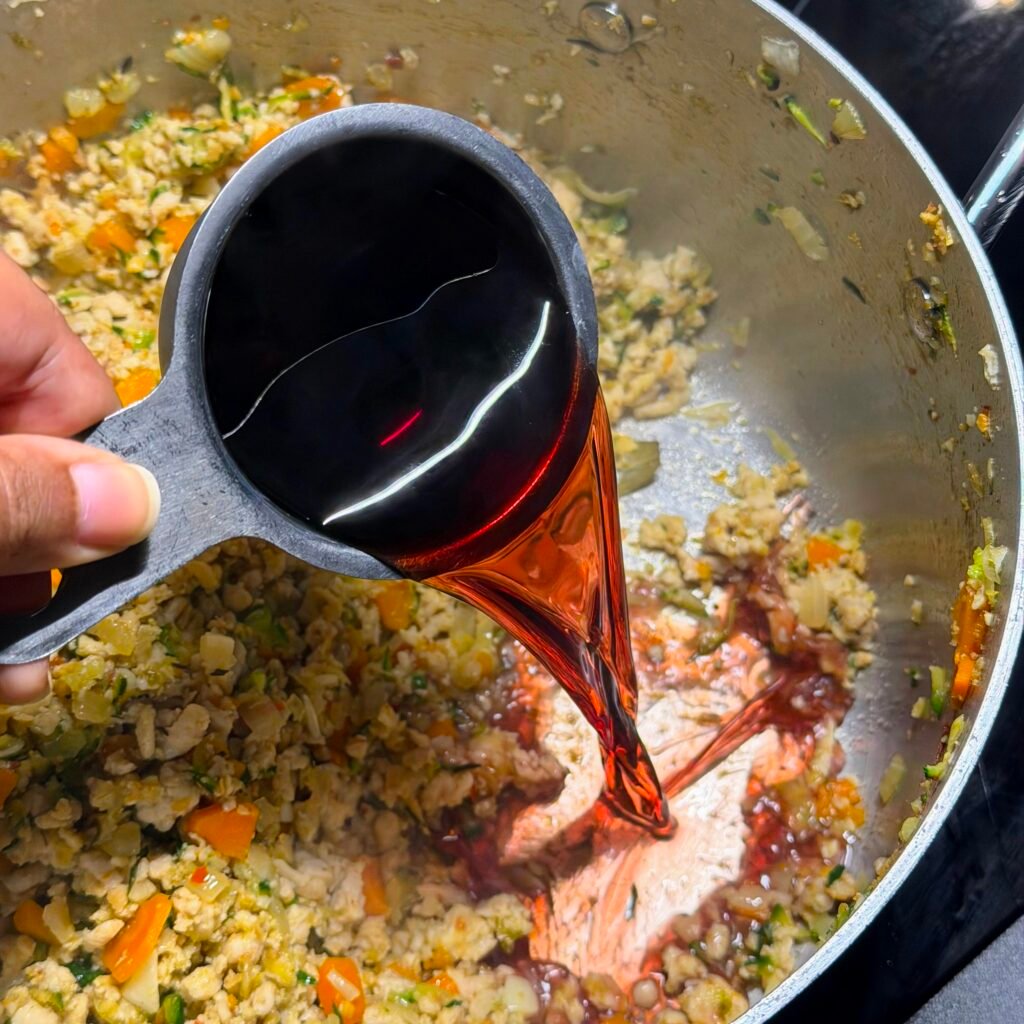
Step 7: Stir in the tomato paste and cook it for about a minute to mellow its raw flavor. Then add the passata and the canned whole tomatoes. Crush the canned tomatoes gently with the back of your spoon. Rinse each empty can with a splash of water and pour that in too — it adds just the right amount of liquid and ensures nothing goes to waste.
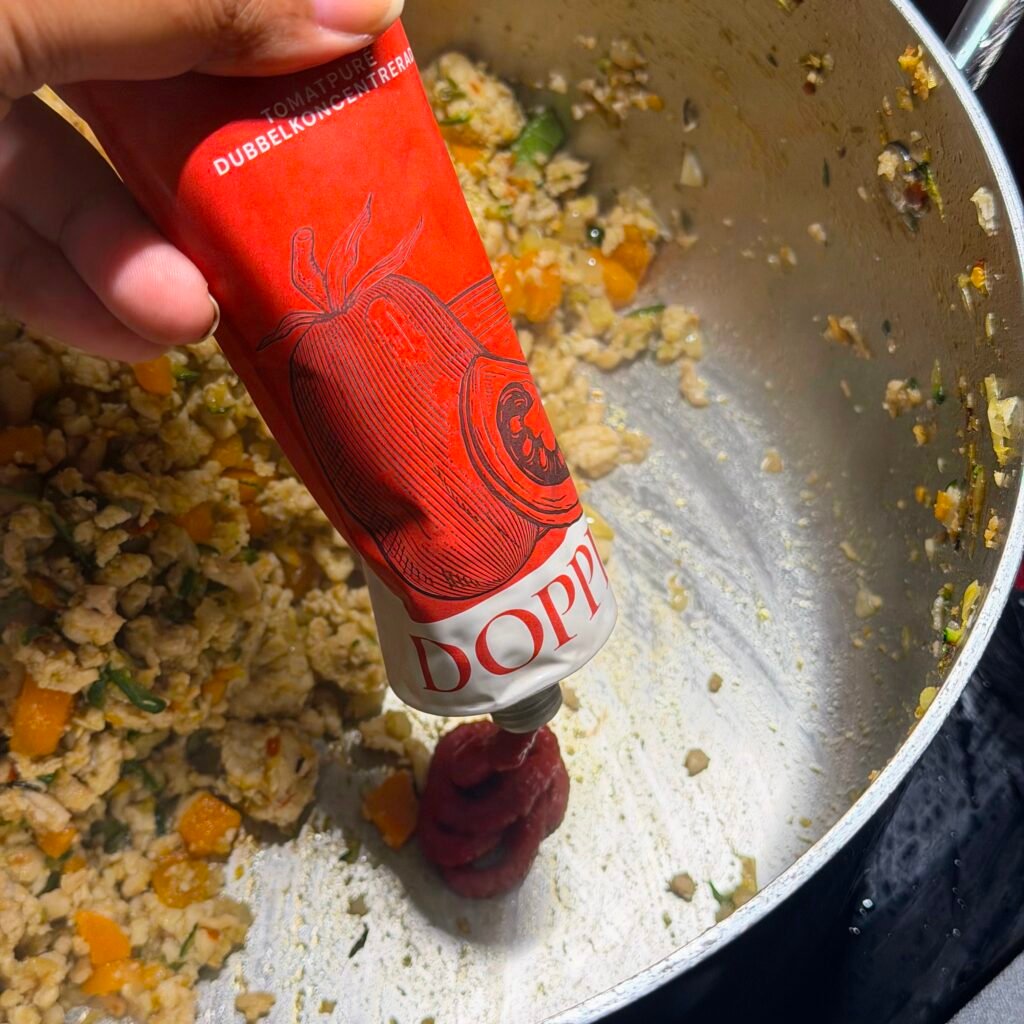
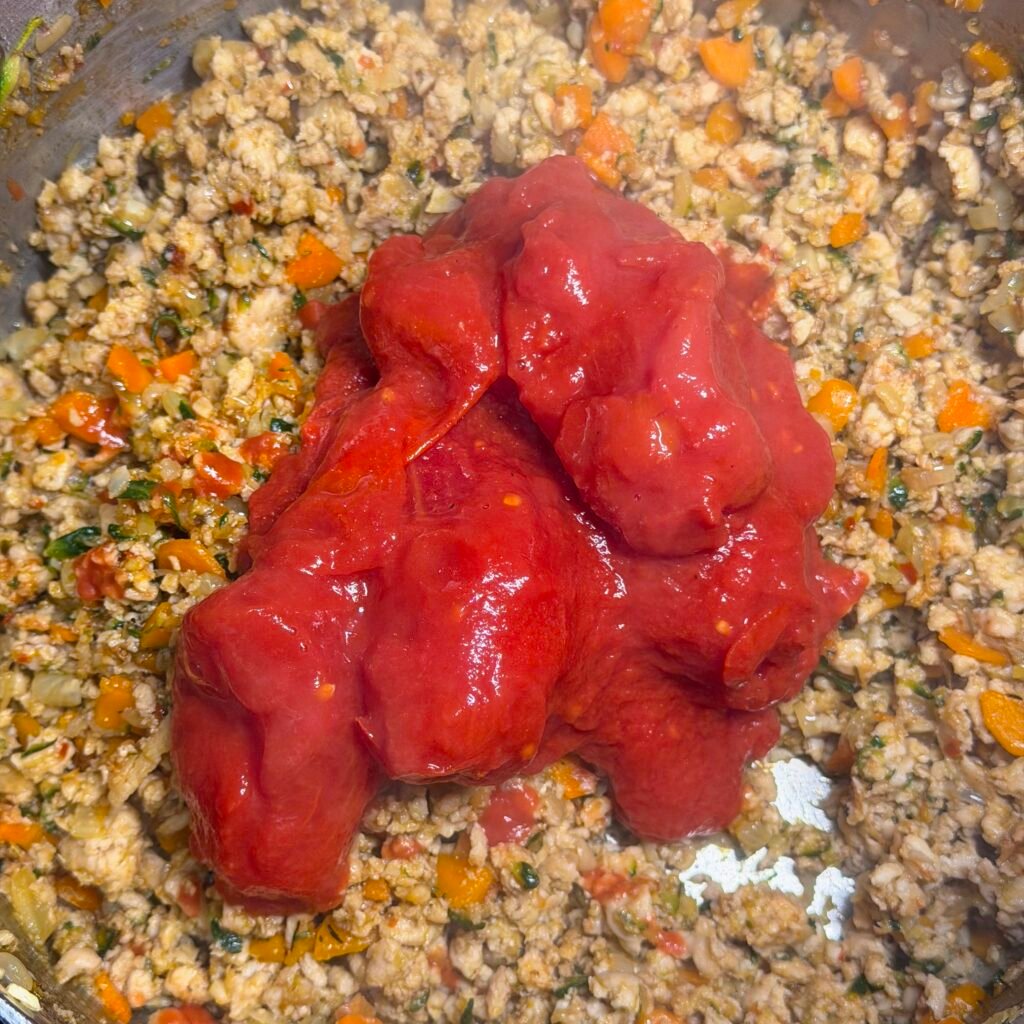
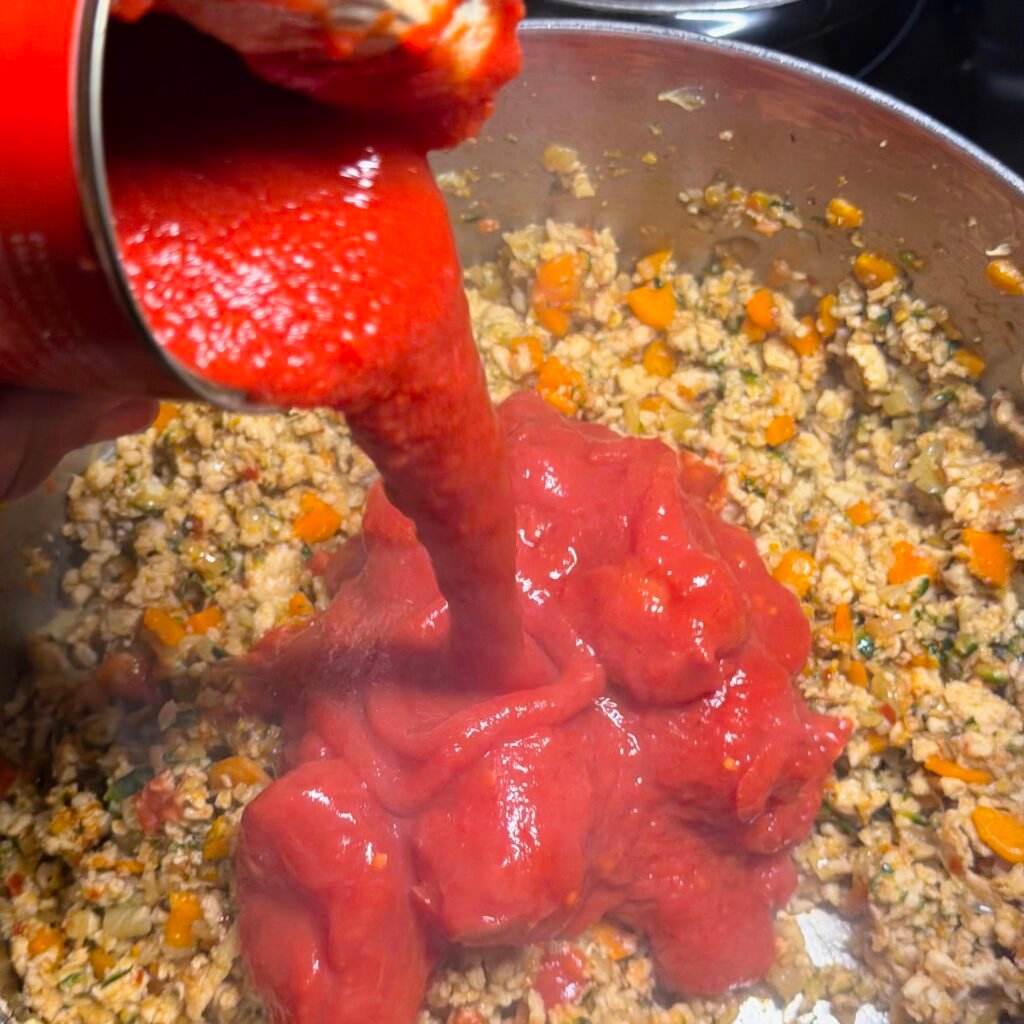
For this recipe, I like to use a mix of passata and canned whole peeled tomatoes — it gives you the best of both worlds.
- Passata (which is basically sieved, uncooked tomatoes) creates a smooth, velvety base for the sauce. It’s pure tomato flavor without the skins or seeds, which helps the sauce coat the pasta beautifully.
- Canned whole peeled tomatoes add texture and a bit of rustic sweetness. When they cook down, they bring a slow-roasted depth that makes the sauce taste like it’s been simmering all day — even if it hasn’t.
Using both together builds a sauce that’s rich, balanced, and layered in flavor — not too sharp, not too heavy.
If you can’t find passata:
- You can use tomato purée (just dilute with water to get a similar consistency).
- Or blend a can of diced or crushed tomatoes until smooth — it’s a great substitute in a pinch.
If you don’t have canned peeled tomatoes:
- Use two cans of crushed tomatoes instead, or
- Roast a few fresh ripe tomatoes (Roma or plum work best) in the oven, peel them, and add them to the sauce.
Whatever you do – the key is using good-quality, ripe tomatoes. They’ll make all the difference in how naturally sweet and flavorful your sauce turns out.
Step 8: Season with salt, stir everything together, then lower the heat and cover. Let it simmer gently for at least 25–30 minutes. The longer it cooks, the richer and deeper the sauce becomes. Stir occasionally so it doesn’t stick. If the sauce is too tart, you can add a pinch of baking soda and also some sugar to neutralize the acid and balance the flavours.
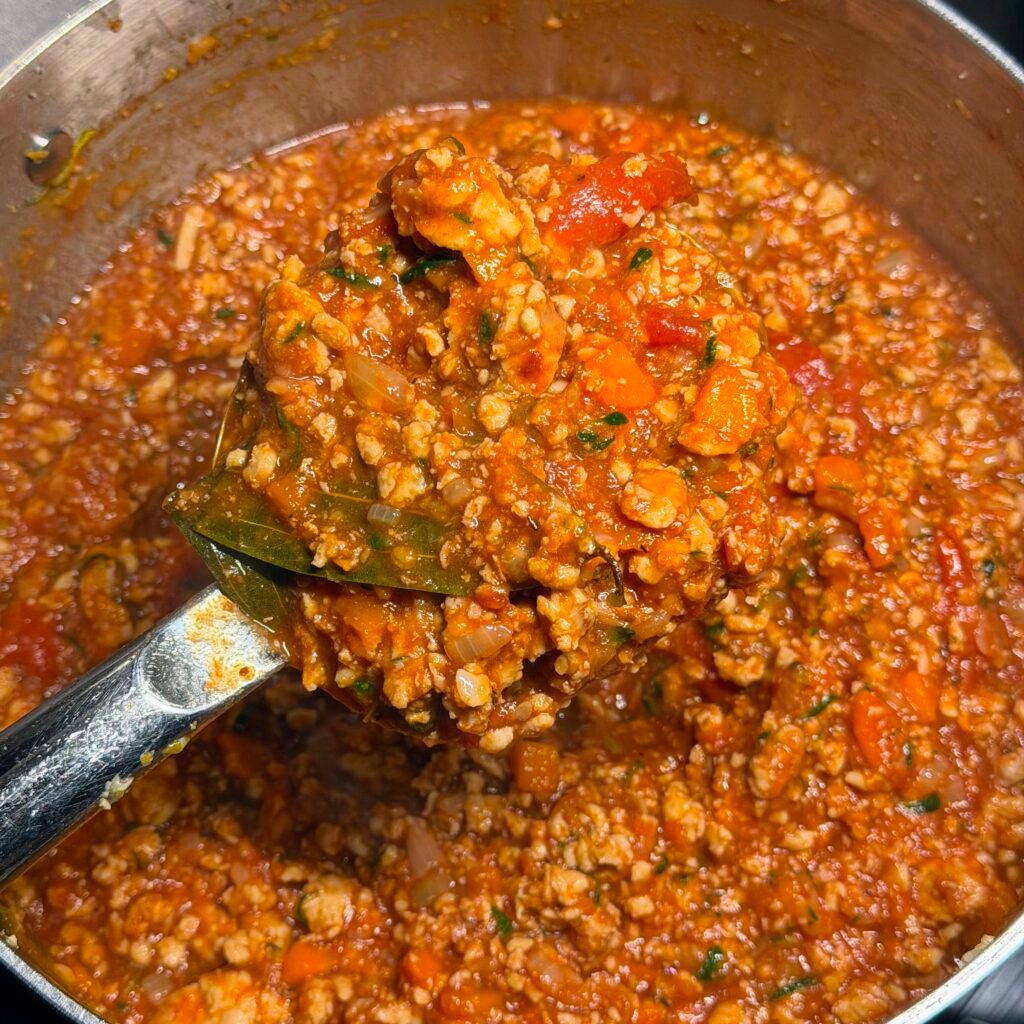
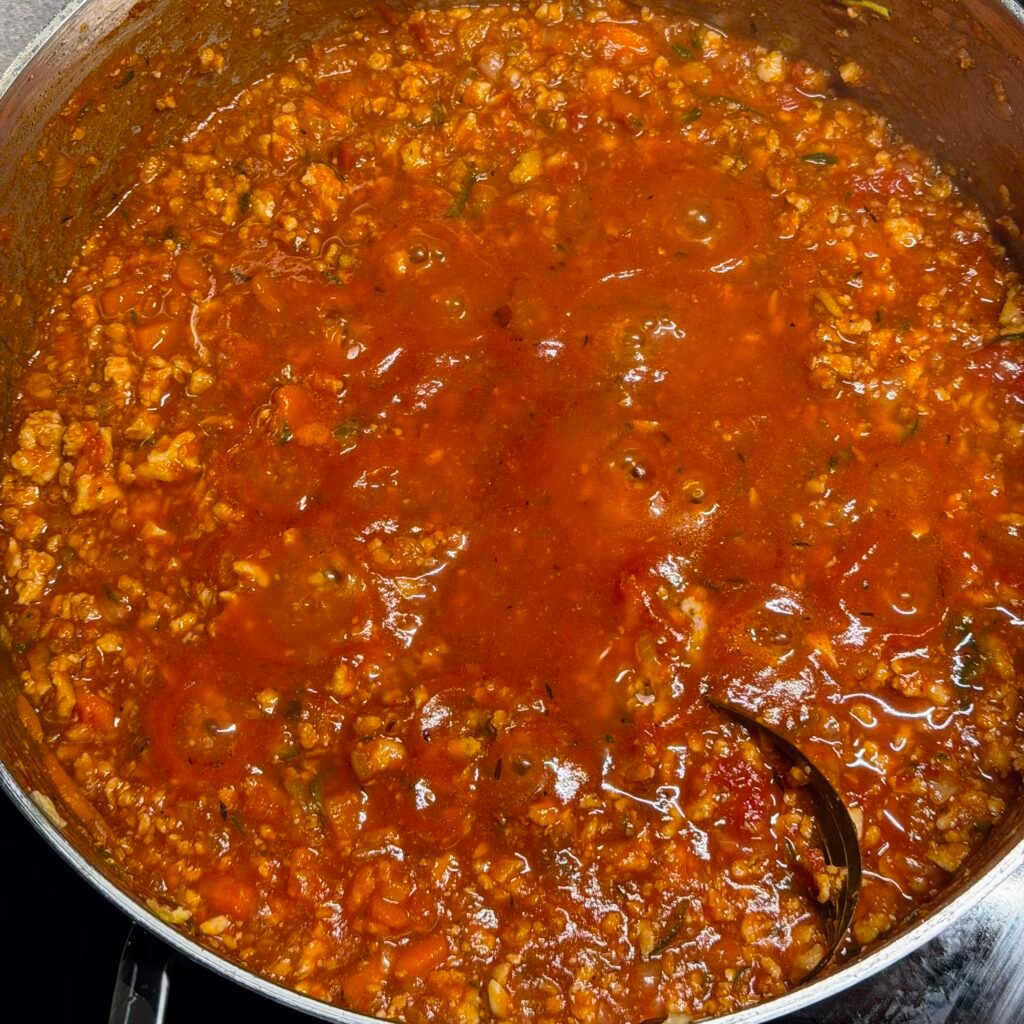
Shortcut tip: You can make this sauce a day ahead. The flavor actually improves overnight, and it makes assembling the lasagna faster later. Optionally, you can make a large batch and freeze it in portions so you can make lasagna anytime! Additionally, you can make this and add cooking cream and layer the lasagna with just this.
2. Make the Creamy Béchamel Sauce
The white sauce might sound fancy, but it’s really simple — just a bit of stirring and patience.
Step 1: In a medium saucepan, melt the butter over medium heat. When it’s fully melted and bubbling, add the flour.
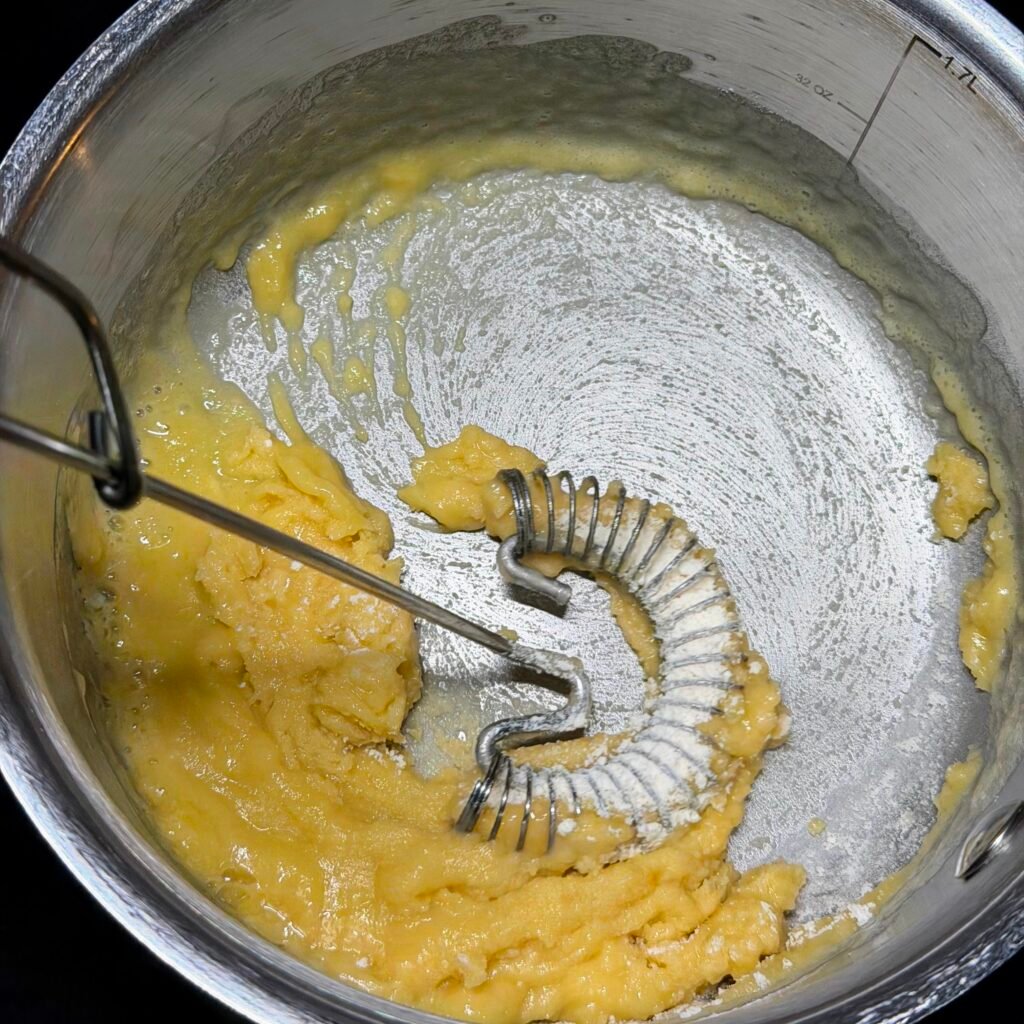
Step 2: Whisk constantly until it forms a smooth paste (this is called a roux). You’ll notice it starts to smell slightly nutty — that’s when you know the flour has cooked through.
Step 3: Slowly pour in the milk, a little at a time, while whisking continuously. This helps prevent lumps. If you pour too fast, you’ll get clumps — so take your time here.
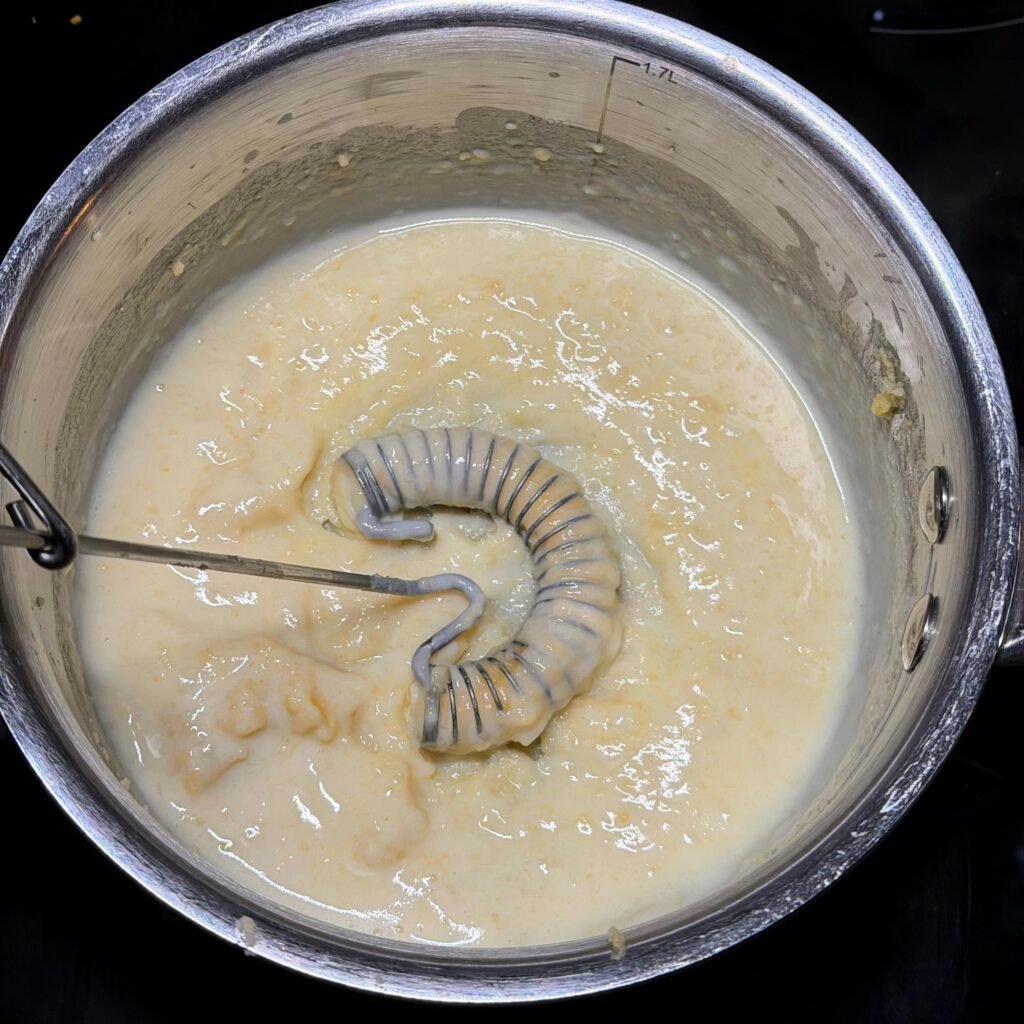
Step 4: Once all the milk is in, keep whisking as the sauce thickens. This can take around 8–10 minutes. It should be smooth, creamy, and thick enough to coat the back of a spoon.
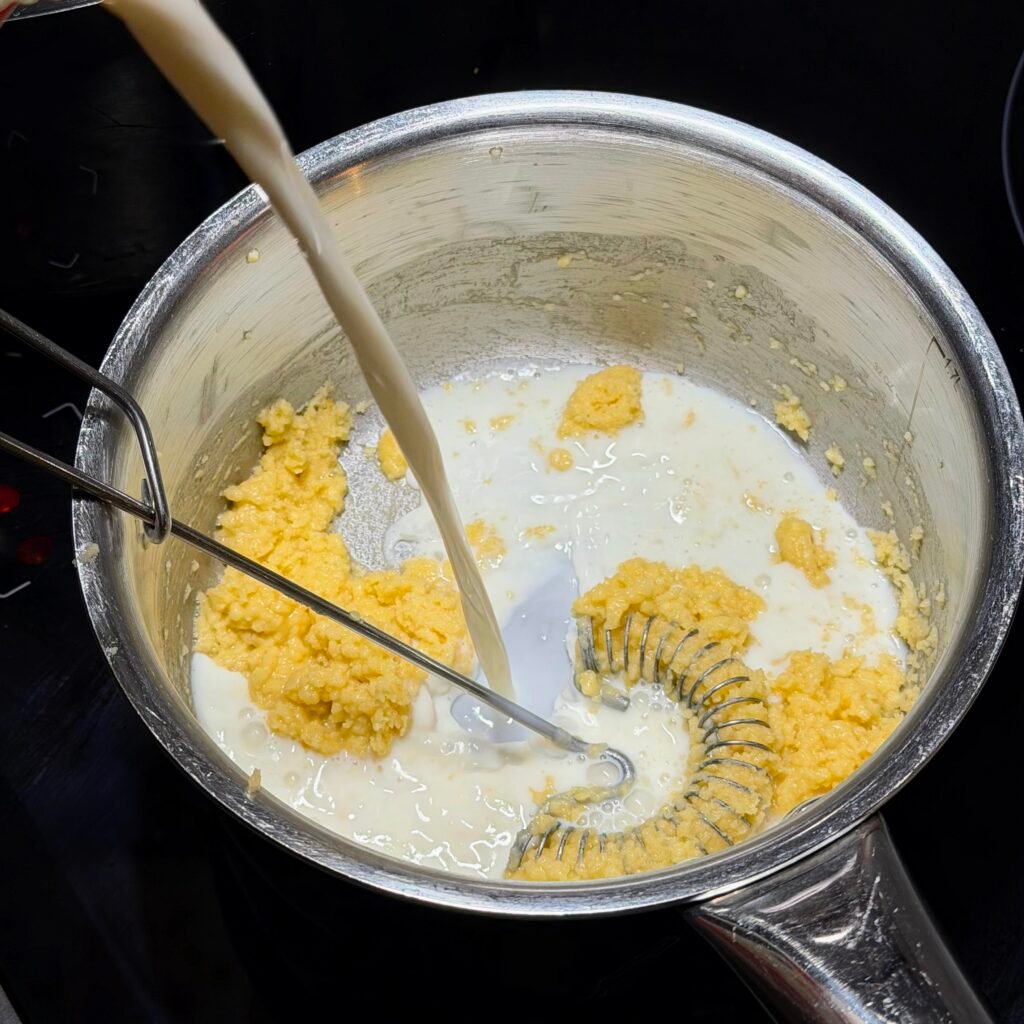
Step 5: Stir in the herbed cream cheese if you’re using it — it gives the béchamel an extra layer of flavor. Season with salt and pepper to taste. If you’re not adding cream cheese add 2-3 tbsp more flour to the roux to help thicken it.
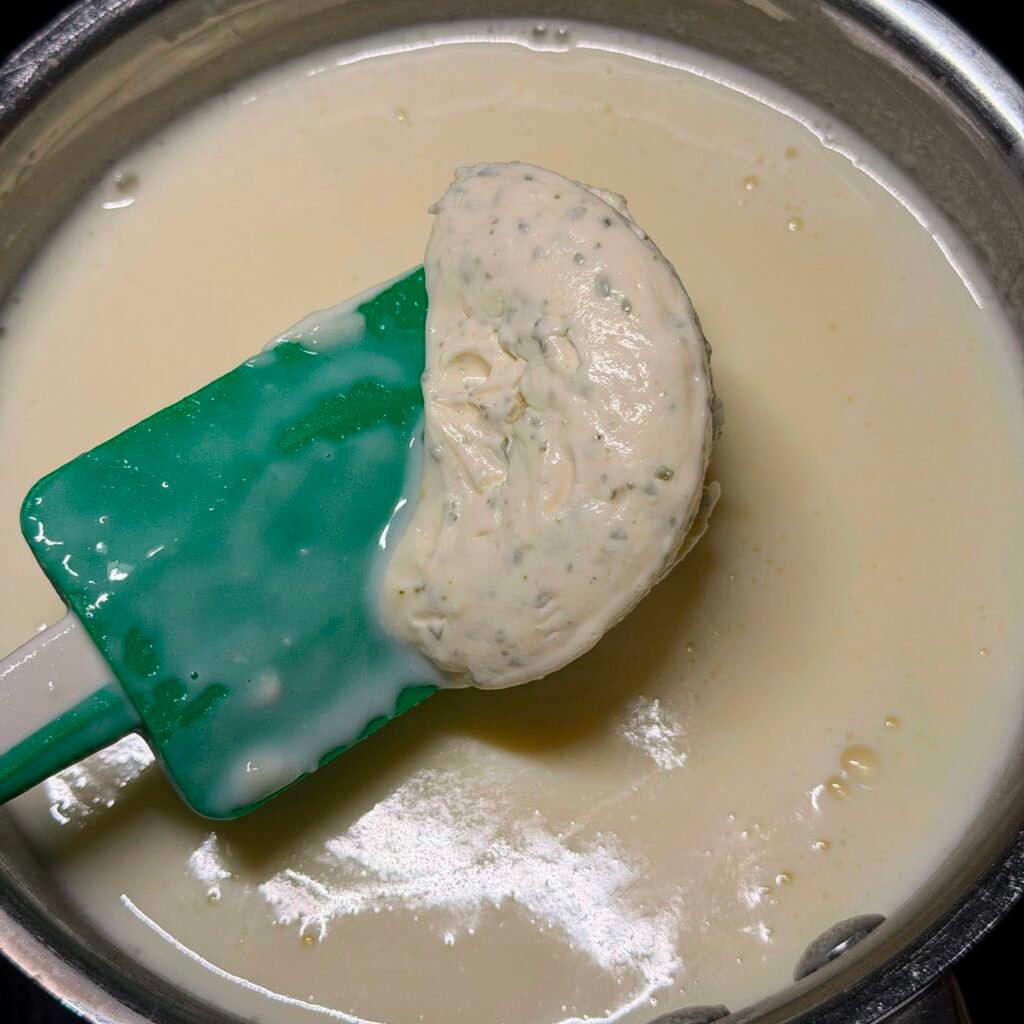
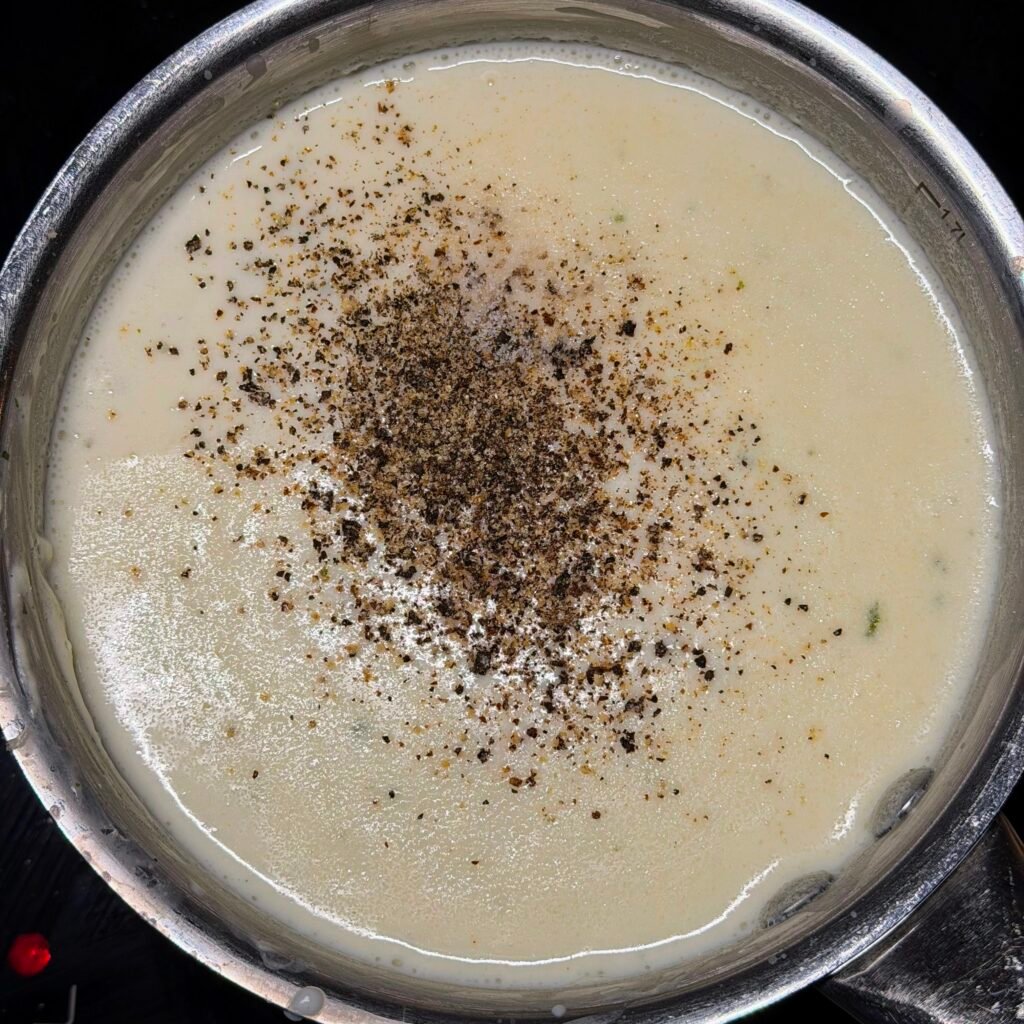
Step 6: Remove it from the heat and set aside. It will thicken slightly as it cools, so don’t worry if it seems a bit runny at first.
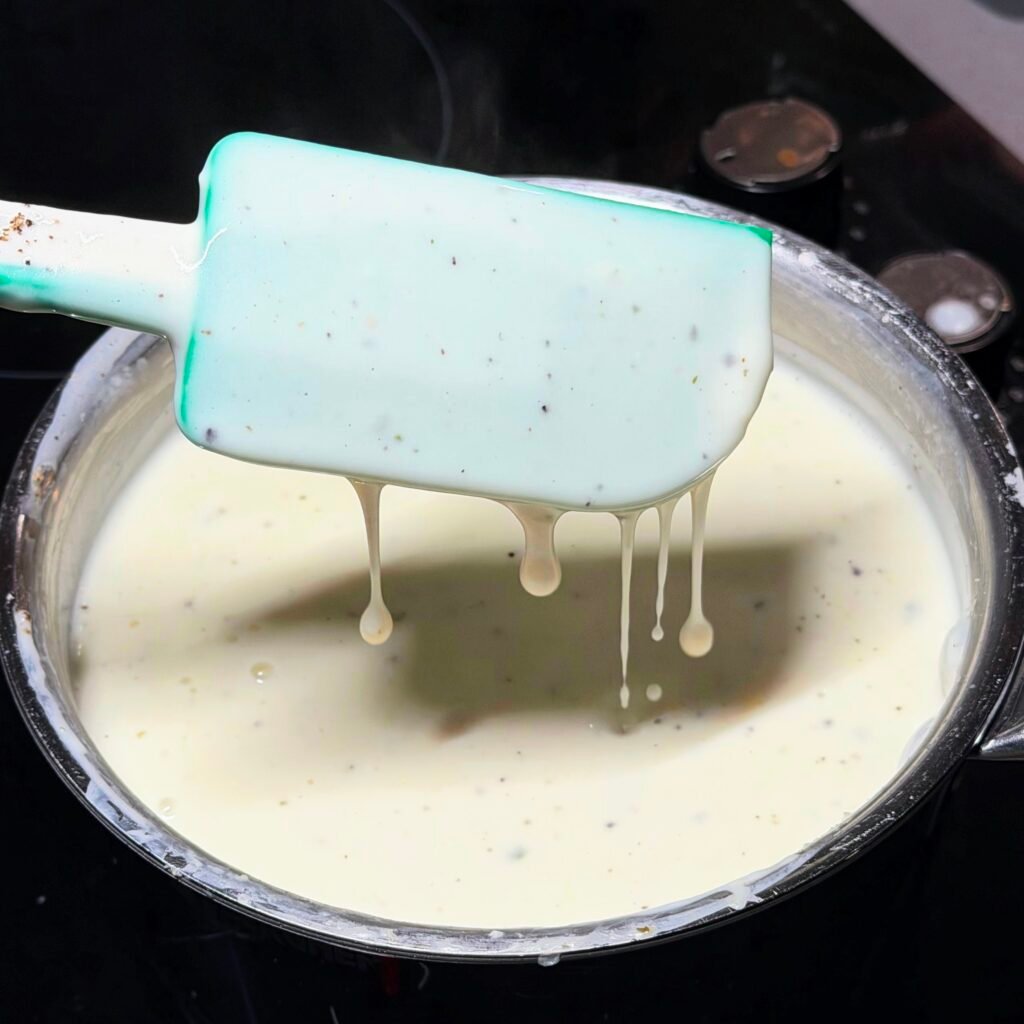
Shortcut tip: If you’re short on time, you can use ricotta for a “lazy” béchamel. You can find my shortcut lasagna here
3. Assemble the Lasagna
This is the fun part. Preheat your oven to 180°C (350°F) and get your baking dish ready.
Step 1: Start with a thin layer of the chicken tomato sauce on the bottom of the dish. This keeps the pasta from sticking.
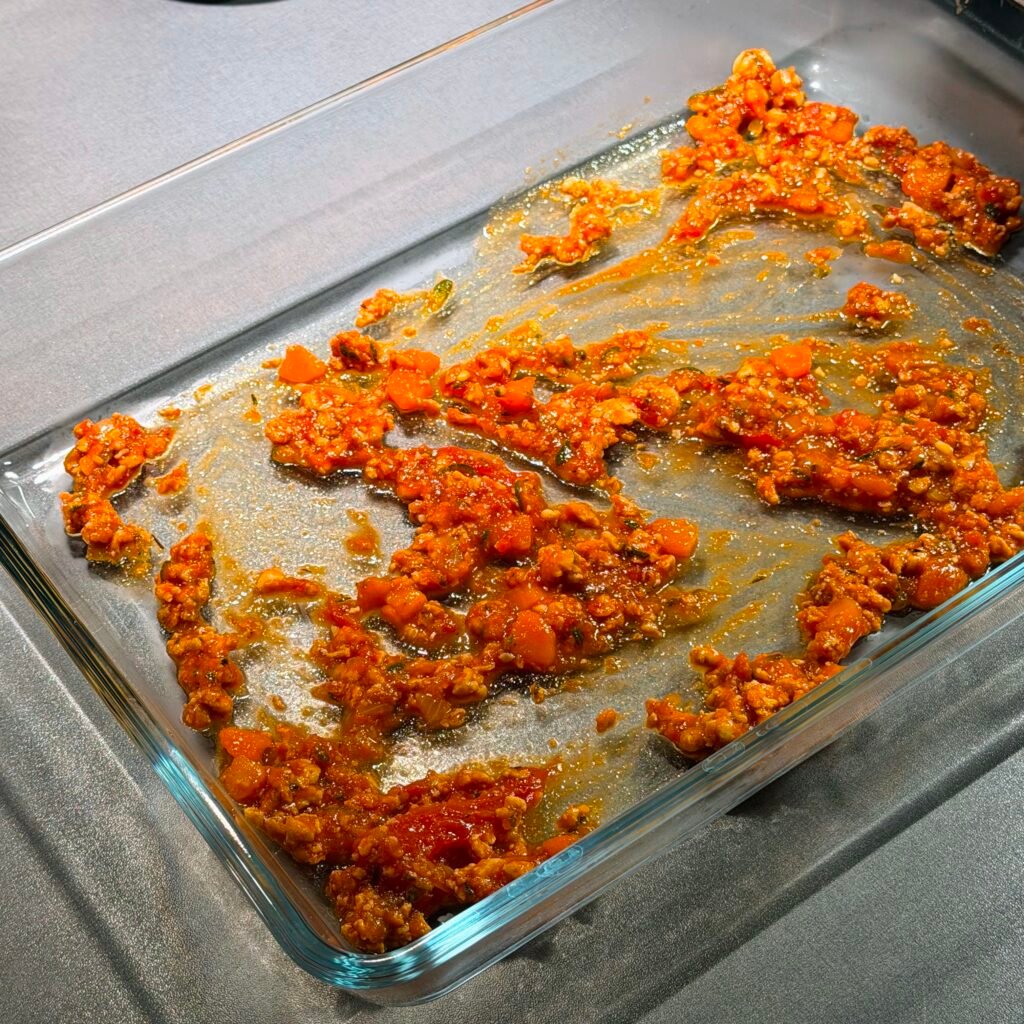
Step 2: Add your first layer of lasagna sheets. If using dried pasta, make sure the sheets overlap slightly so you don’t get gaps.
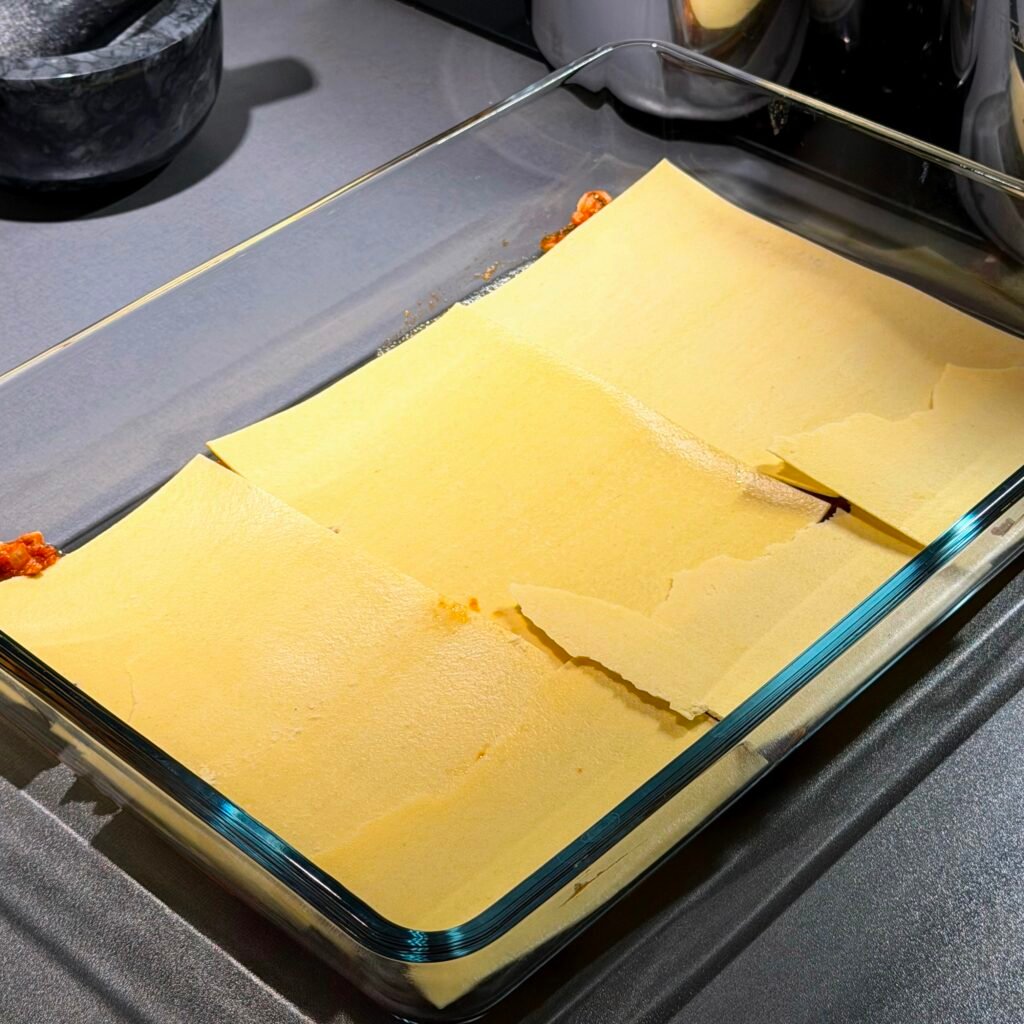
Step 3: Spoon over a generous layer of the tomato sauce, spreading it evenly to the edges.
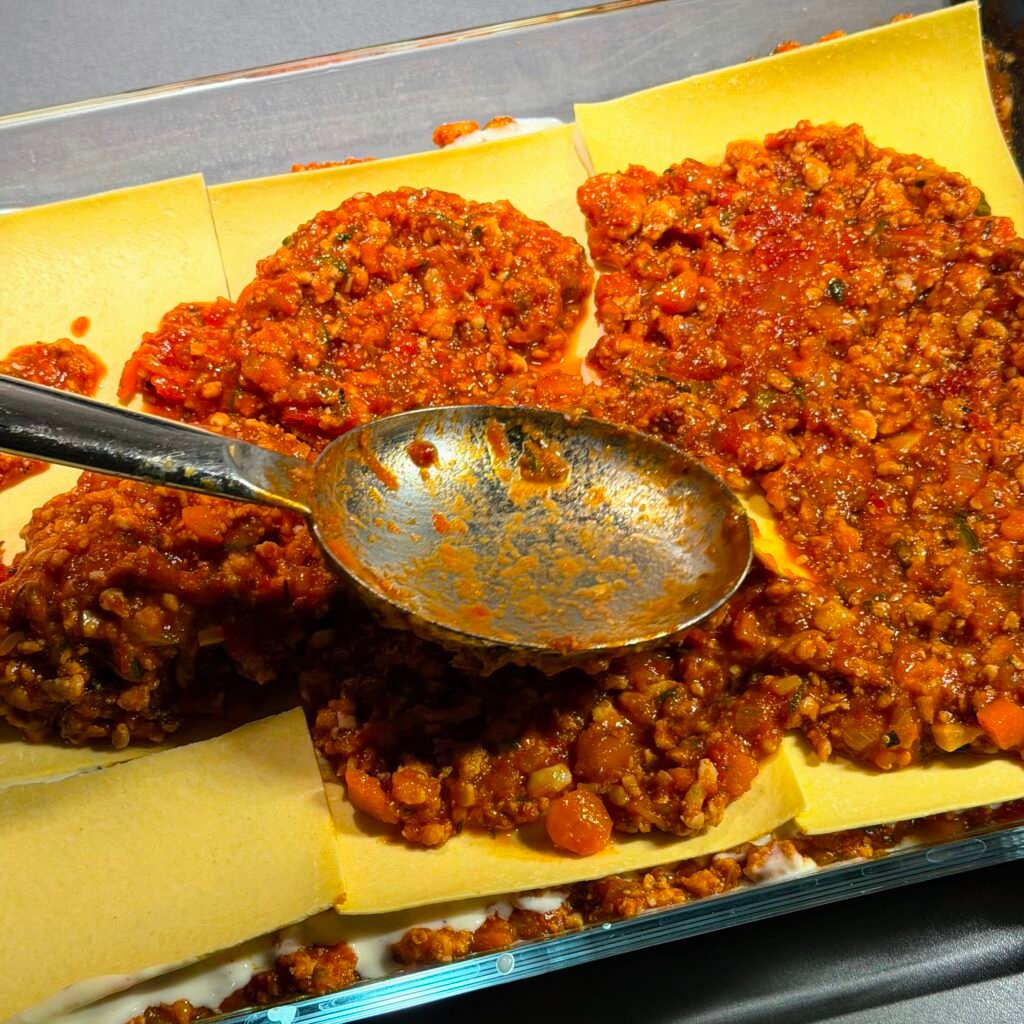
Step 4: Pour a layer of the béchamel sauce over the tomato layer, smoothing it gently with the back of a spoon. Don’t worry if it mixes a bit — that’s normal.
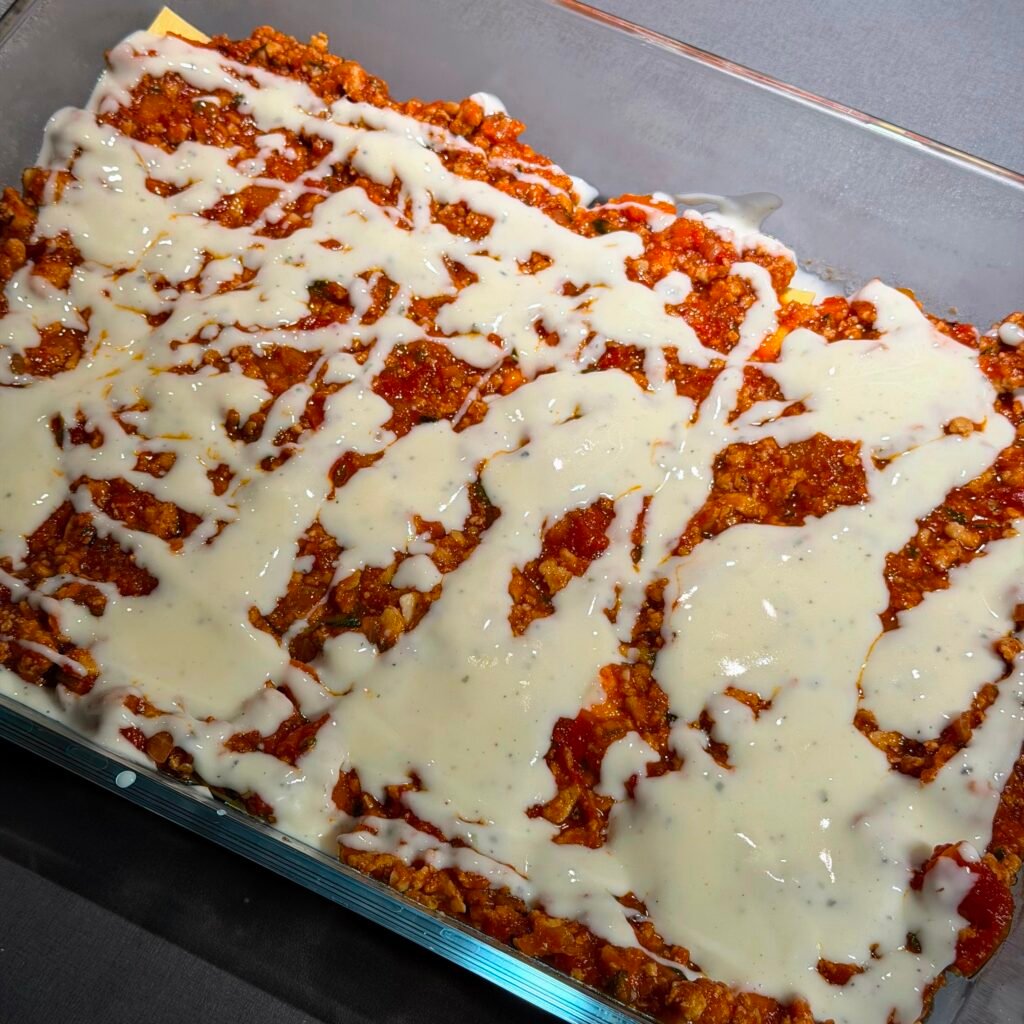
Step 5: Repeat the layers — pasta → tomato → béchamel — until you’ve used up all your sauce. Aim for at least three full layers. Finish with a final layer of pasta, top it with béchamel, and sprinkle a generous handful of mozzarella or your favorite cheese blend on top.
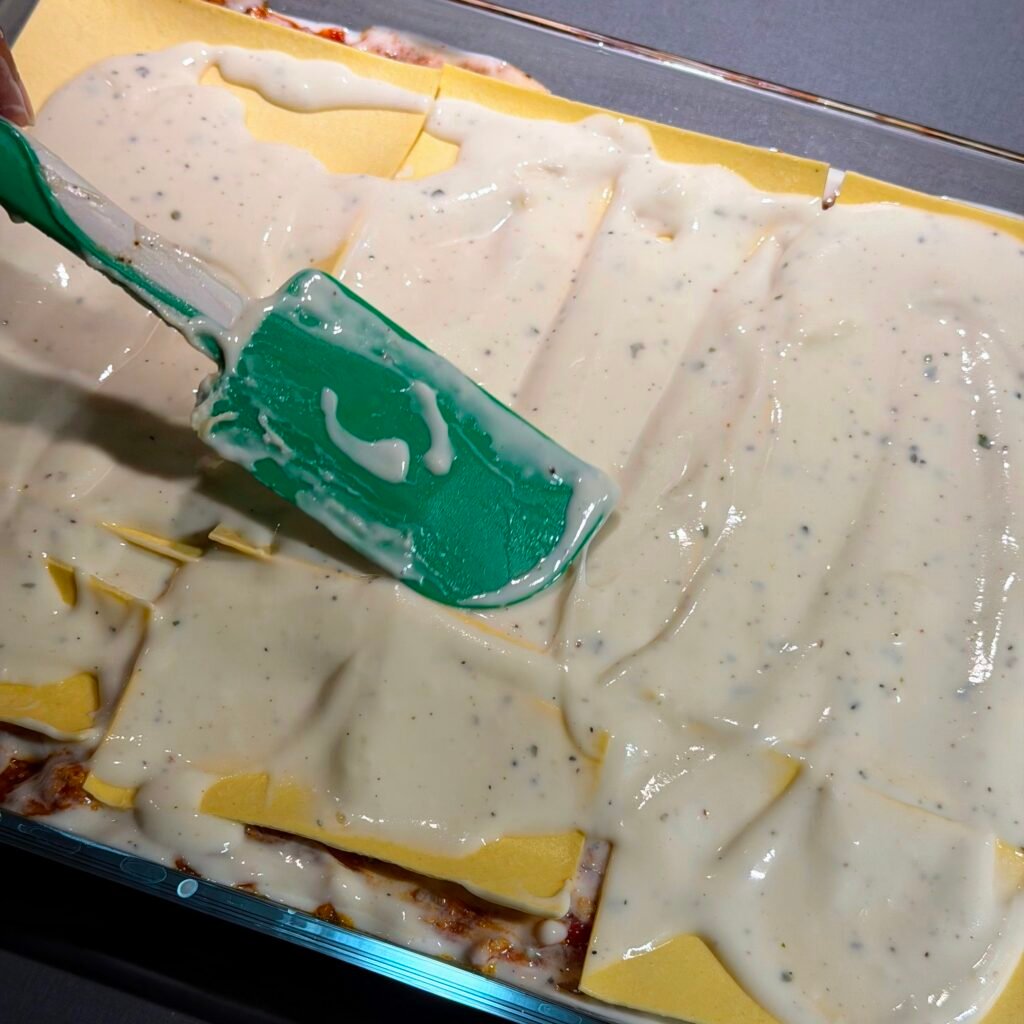
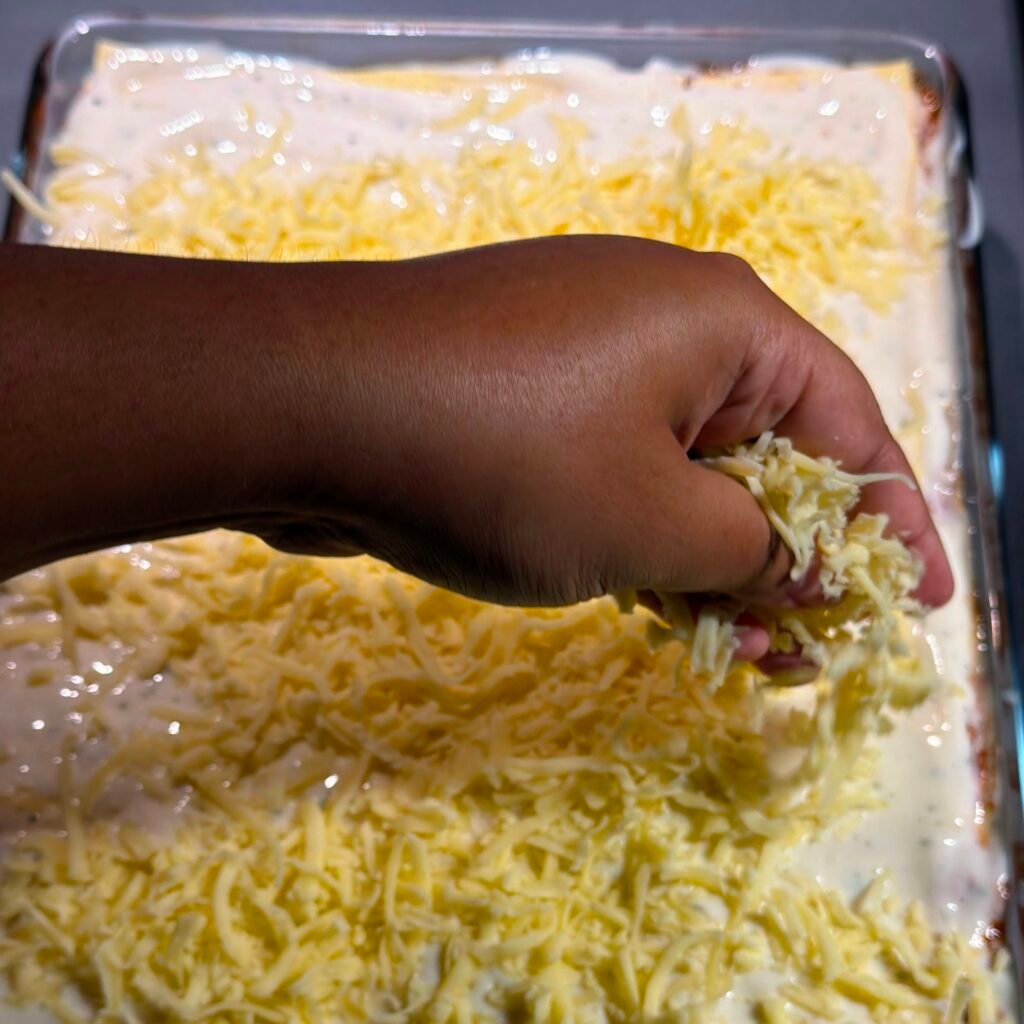
Step 6: Cover the dish with foil (this traps steam and helps cook the pasta evenly). Bake for 40–45 minutes. If you’re using fresh pasta, start checking for doneness around the 30-minute mark.
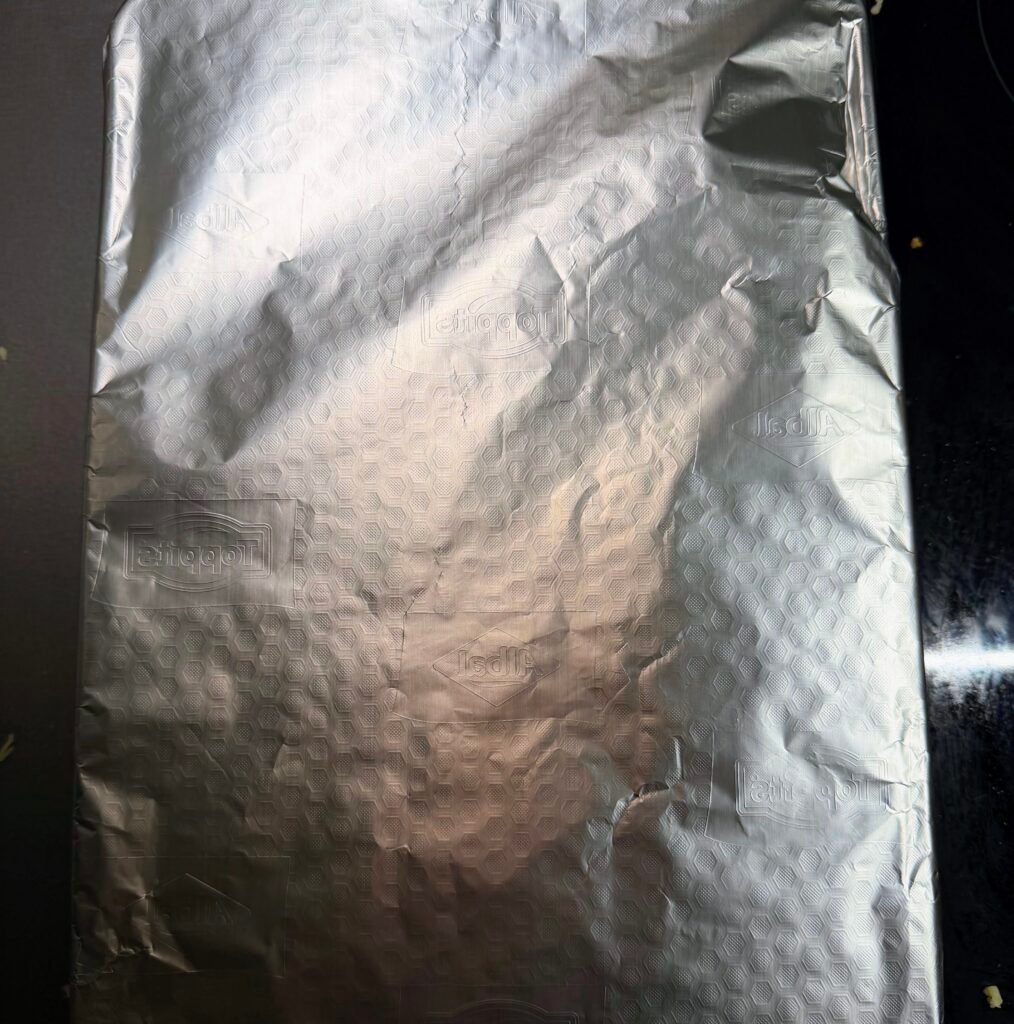
Step 7: Remove the foil and switch your oven to broil/grill mode. Bake uncovered for another 10 minutes, or until the top is golden brown and bubbling.
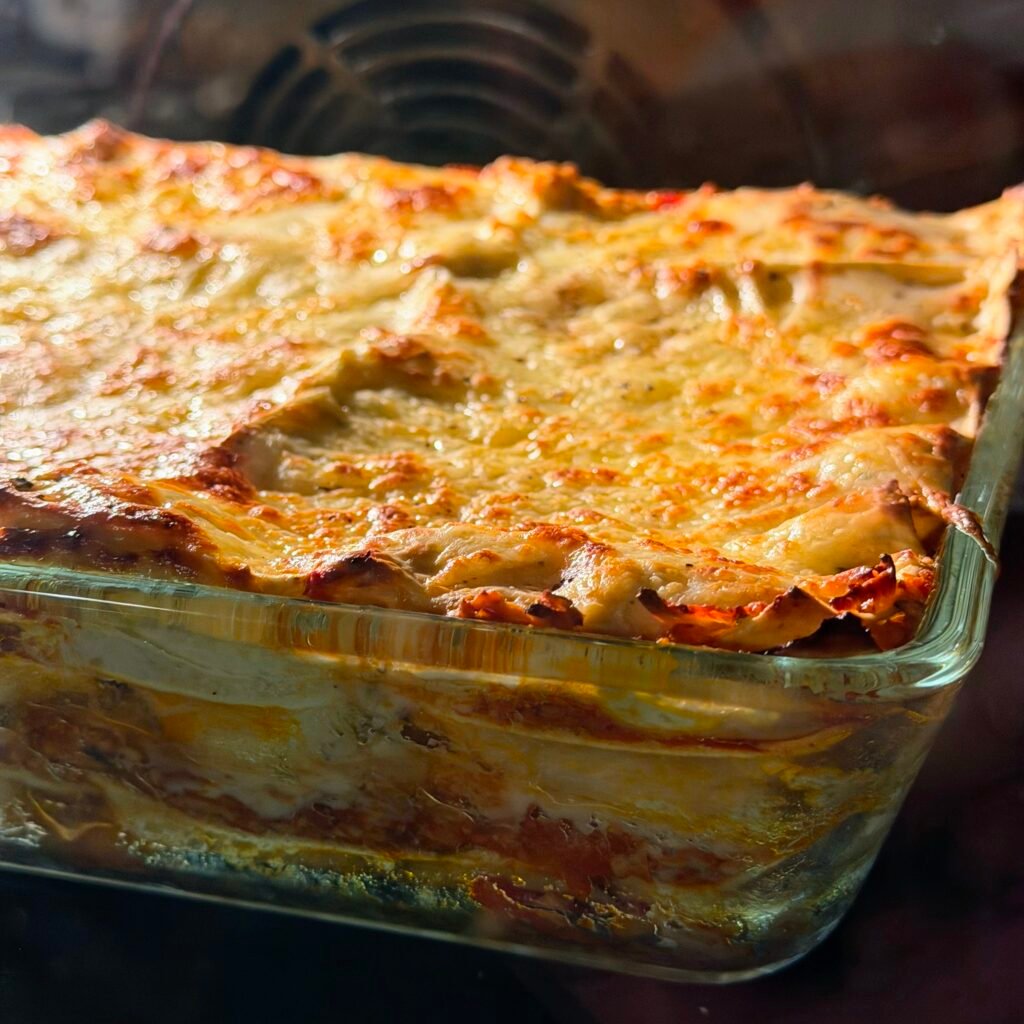
Step 8: Once baked, resist the temptation to slice it immediately! Let the lasagna rest for at least 15 minutes. This allows the layers to set and makes it easier to cut clean, neat slices.
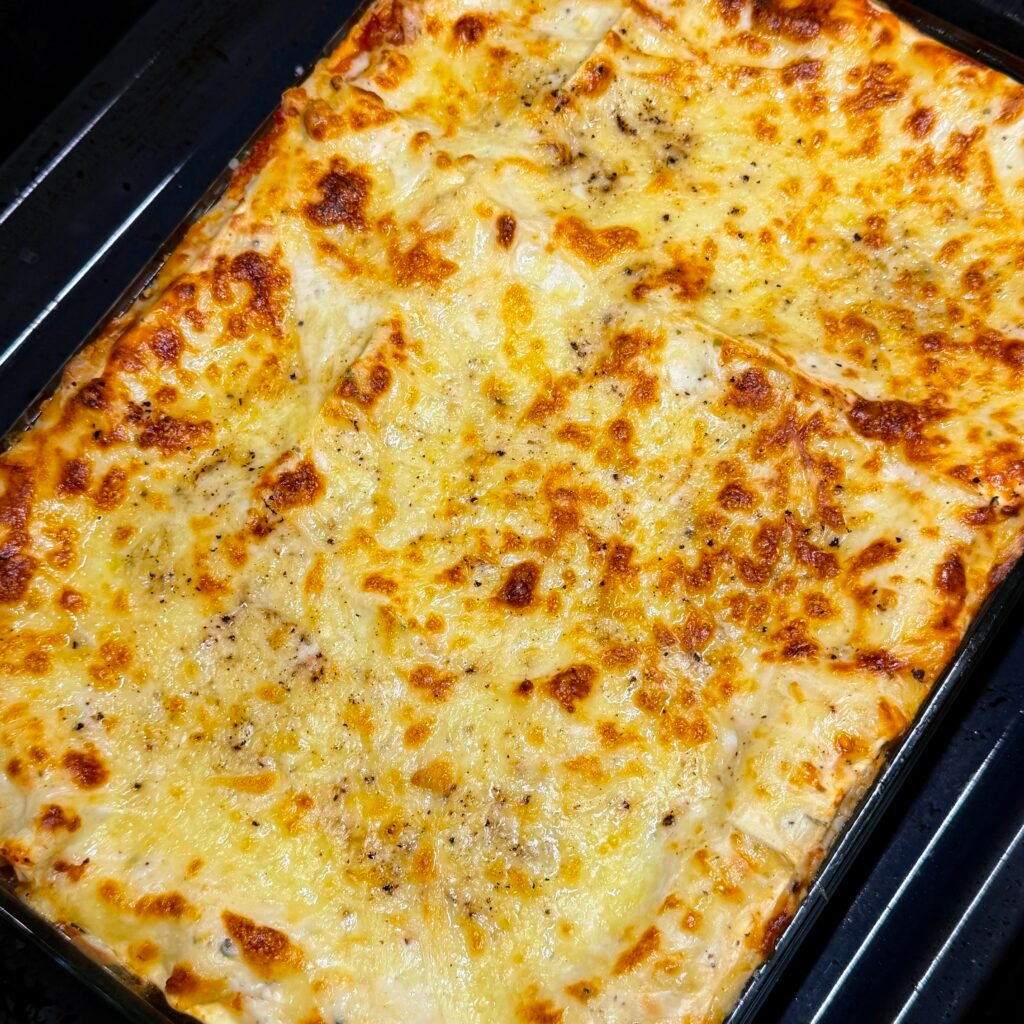
Serve it hot with a crisp green salad or some buttery garlic bread — it’s comfort food perfection.
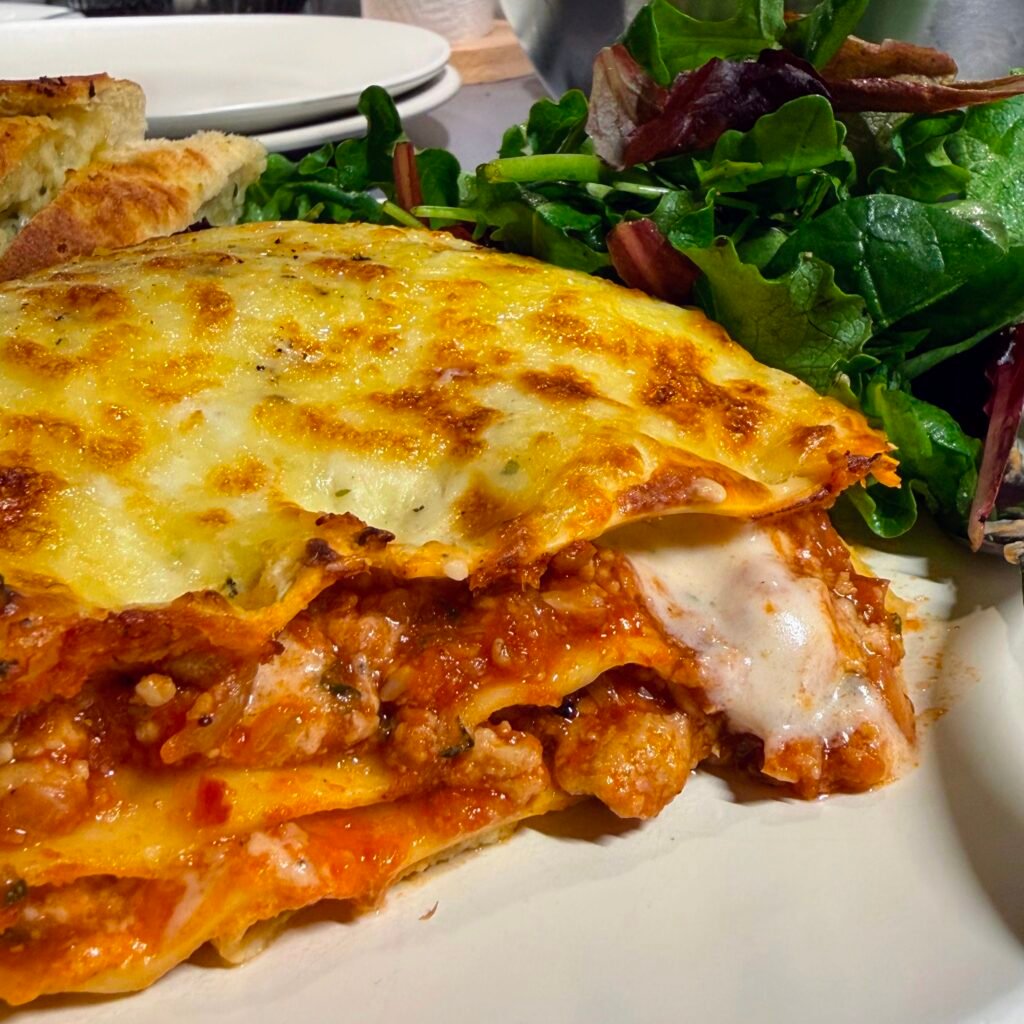
Storage & Make-Ahead Tips
- Refrigerate: Store leftovers in an airtight container for up to 3 days.
- Freeze: You can freeze the lasagna in individual portions for easy reheating. Bake straight from frozen at 180°C until hot in the center.
- Make Ahead: Both sauces can be prepared a day in advance. You can even assemble the entire lasagna, cover, and refrigerate overnight — just add 10 extra minutes to the baking time if baking straight from the fridge.
Variations to Try
- Add spinach or mushrooms to the tomato sauce for extra flavor.
- Try half chicken, half sausage mince for a more robust taste.
- Add a layer of roasted vegetables like eggplant or bell peppers for a lighter version.
- Sprinkle a mix of parmesan and mozzarella for that perfect cheesy top crust.
Storage & Make-Ahead Tips
- Fridge: Keeps beautifully for up to 3 days.
- Freezer: Freeze portions for easy future meals — reheat in the oven for best texture.
- Make ahead: The sauce can be made the day before. You can even assemble the lasagna, refrigerate overnight, and bake the next day.
Variations to Try
- Add spinach, mushrooms, or extra herbs for more flavour.
- Try half chicken, half sausage mince for a different version.
- Add a layer of roasted veggies for a lighter take.
FAQs
Q: Can I use store-bought lasagna sheets?
Yes! Fresh sheets cook faster, while dried ones might need extra sauce or a few more minutes in the oven. Always check the package instructions.
Q: What’s the best cheese mix for lasagna?
Mozzarella gives that classic stretch, parmesan adds saltiness, and cheddar brings depth — a combo of all three works beautifully.
Q: Can I skip the wine in the sauce?
Definitely. Just use chicken broth instead. The wine adds richness, but it’s completely optional.
Q: Why does my lasagna fall apart when I cut it?
It’s probably too hot! Letting it rest for at least 15 minutes after baking helps it firm up and slice cleanly.
Q: What kind of tomatoes should I use for the sauce?
I like using a mix of passata and canned whole peeled tomatoes — passata gives a smooth base, while the canned tomatoes add a deeper, more rustic flavor. If you don’t have access to these, you can substitute tomato purée (thinned slightly with water) and blended diced tomatoes. The key is to choose good-quality, ripe tomatoes, as that’s what gives the sauce its naturally sweet, balanced flavor.
Final Thoughts
This chicken lasagna isn’t fussy — just honest, cozy, and full of flavour. Take your time with it when you can, or use the shortcuts when you need to. Either way, it’s one of those dishes that always brings people to the table (and usually has everyone going back for seconds).
Chicken Lasagne with Tomato & Béchamel Sauce
Course: MainCuisine: ItalianDifficulty: Medium6-8
servings20
minutes2
hours2
hours20
minutesA rich, comforting chicken lasagne layered with a deeply flavoured tomato-based chicken sauce and a silky béchamel. It’s easy to make, feeds a crowd, and tastes even better the next day. Perfect for cozy dinners or meal prep.
Ingredients
- For the Chicken Tomato Sauce
2-3 tbsp olive oil
750g chicken mince
1 bay leaf
2 white onions, diced
2 medium carrots, diced
1 whole bulb garlic, finely chopped
1.5 tsp chilli flakes
½ tsp thyme
1 tsp oregano
1 zucchini, grated (optional – adds moisture and is a hidden veggie!)
½ cup red wine or 1 cup chicken broth
1 tbsp tomato paste
400g passata
400g canned peeled whole tomatoes
Water, as needed (rinse tomato cans to add)
Salt, to taste
- For the Béchamel Sauce
3 tbsp butter
¼ cup flour
1 L whole milk (3% fat)
90g herbed cream cheese (optional; if omitted, add 2–3 tbsp more flour)
Salt & pepper, to taste
- For Assembly
Fresh or dried lasagne sheets
Shredded mozzarella or cheese blend (for topping)
Directions
- Make the Chicken Tomato Sauce
- Heat olive oil in a large pan on medium heat.
- Add chicken mince, season lightly with salt, and spread evenly in the pan.
- Let it brown without stirring until the bottom caramelizes, then break into small chunks.
- Add onions, bay leaf, carrots, and garlic. Mix, cover, and cook 10–15 minutes to soften.
- Stir in chilli flakes, thyme, and oregano. Cook covered 5–7 minutes.
- Add grated zucchini (if using). Increase heat to cook off moisture and get light caramelization.
- Deglaze with red wine or chicken broth. Cook until the alcohol smell disappears.
- Add tomato paste, passata, and canned tomatoes. Add a splash of water if needed.
- Simmer on low, covered, for 25–30 minutes (the longer, the richer the flavour).
- Make the Béchamel Sauce
- In a saucepan, melt butter over medium heat.
- Add flour and whisk until smooth (no lumps).
- Gradually pour in milk, whisking continuously.
- Cook, stirring often, until the sauce thickens and coats the back of a spoon.
- Stir in herbed cream cheese (if using), and season with salt and pepper.
- Remove from heat – it will thicken more as it cools.
- Assemble the Lasagne
- Preheat oven to 180°C (350°F).
- Spread a thin layer of chicken tomato sauce on the base of your baking dish.
- and then layer as follows:
- Pasta → Tomato → White → Pasta → Tomato → White → Pasta → White → Cheese
- Cover with foil and bake 40–45 minutes (check pasta doneness at 30 minutes).
- Remove foil and broil for 10 minutes until the top is golden and lightly charred.
- Rest & Serve
- Let the lasagne rest for atleast 15 minutes before slicing – this helps it set beautifully.
- Serve hot, with a green salad or garlic bread.
Notes
- Fresh pasta cooks differently than dried; adjust baking time if using dried sheets (follow package directions).
- Great for leftovers — refrigerate up to 3 days or freeze portions for easy reheating.
- Add spinach, mushrooms, or extra herbs for variation.
- The sauce can be made ahead a day before to save time.
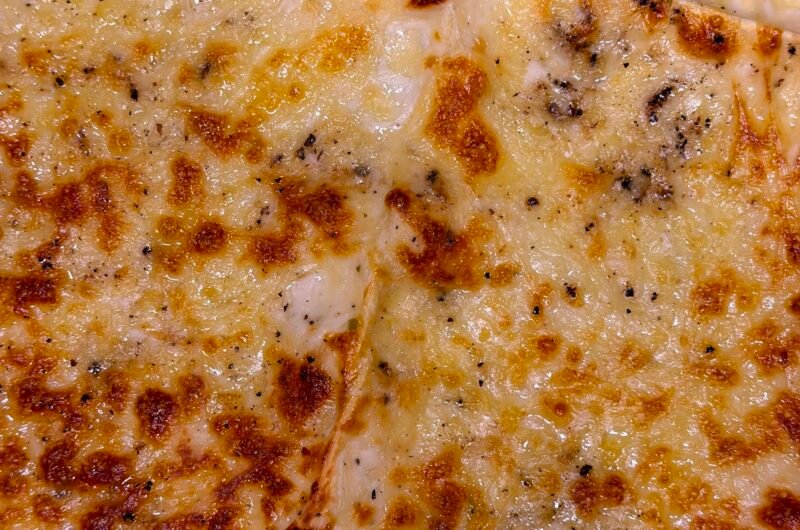






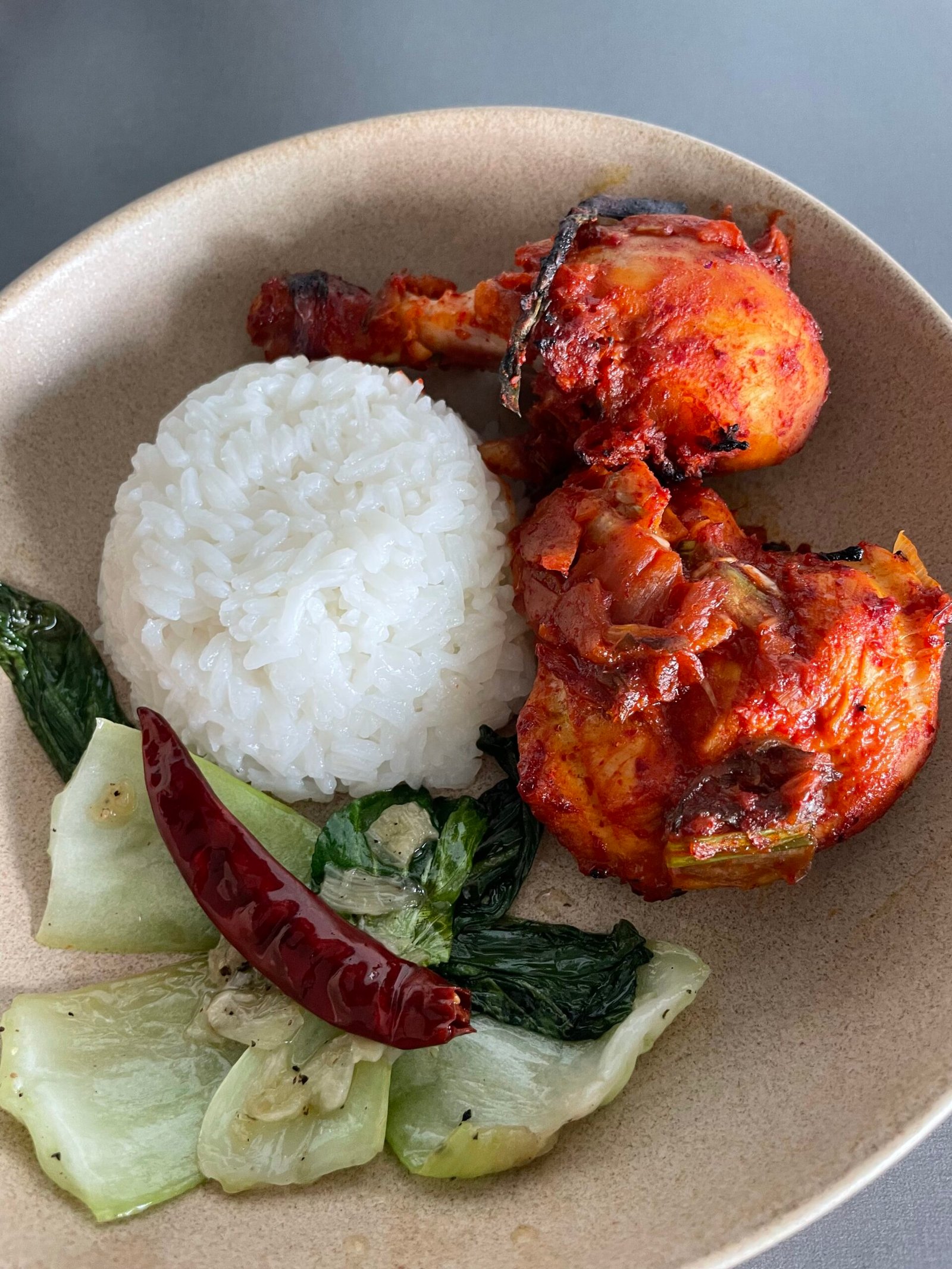
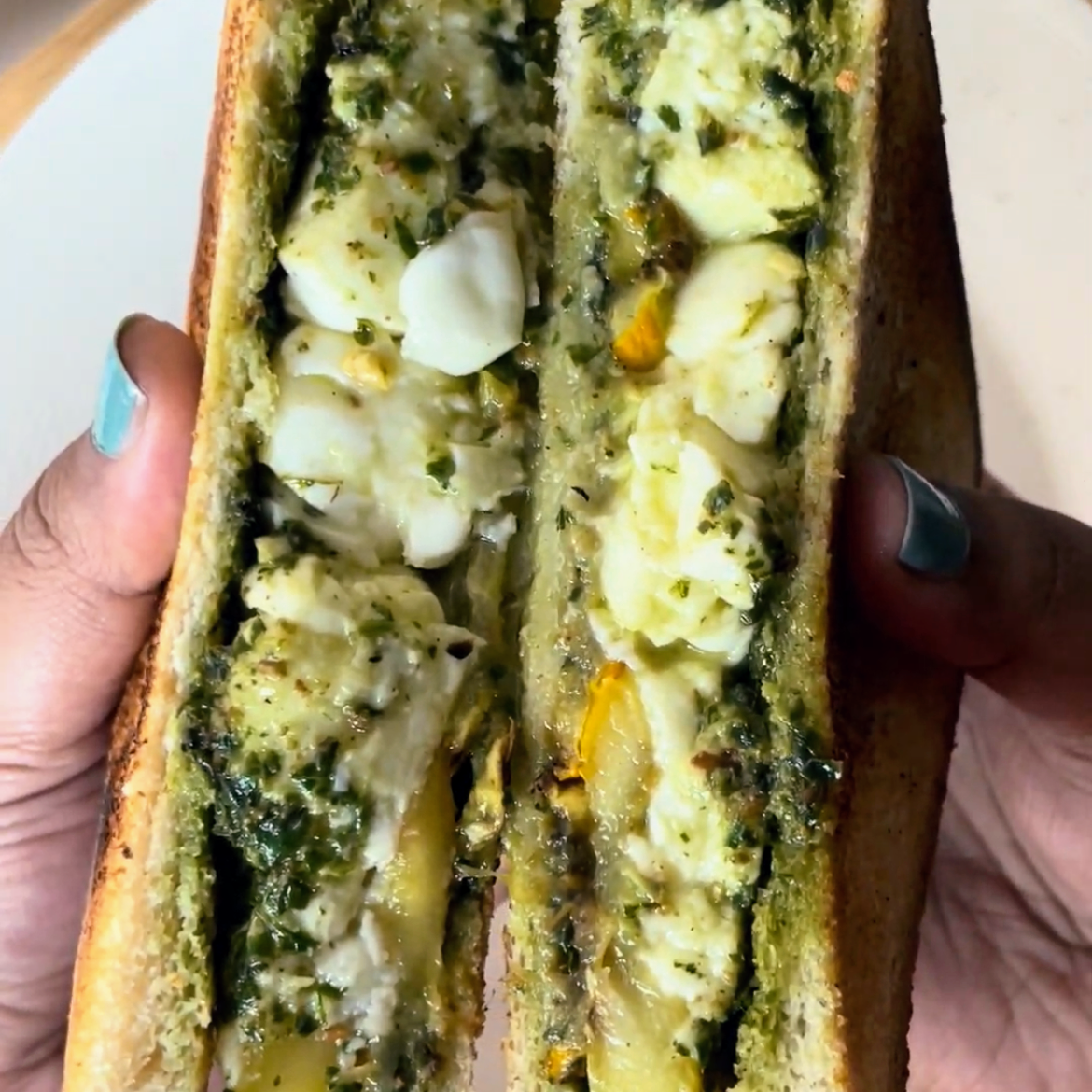
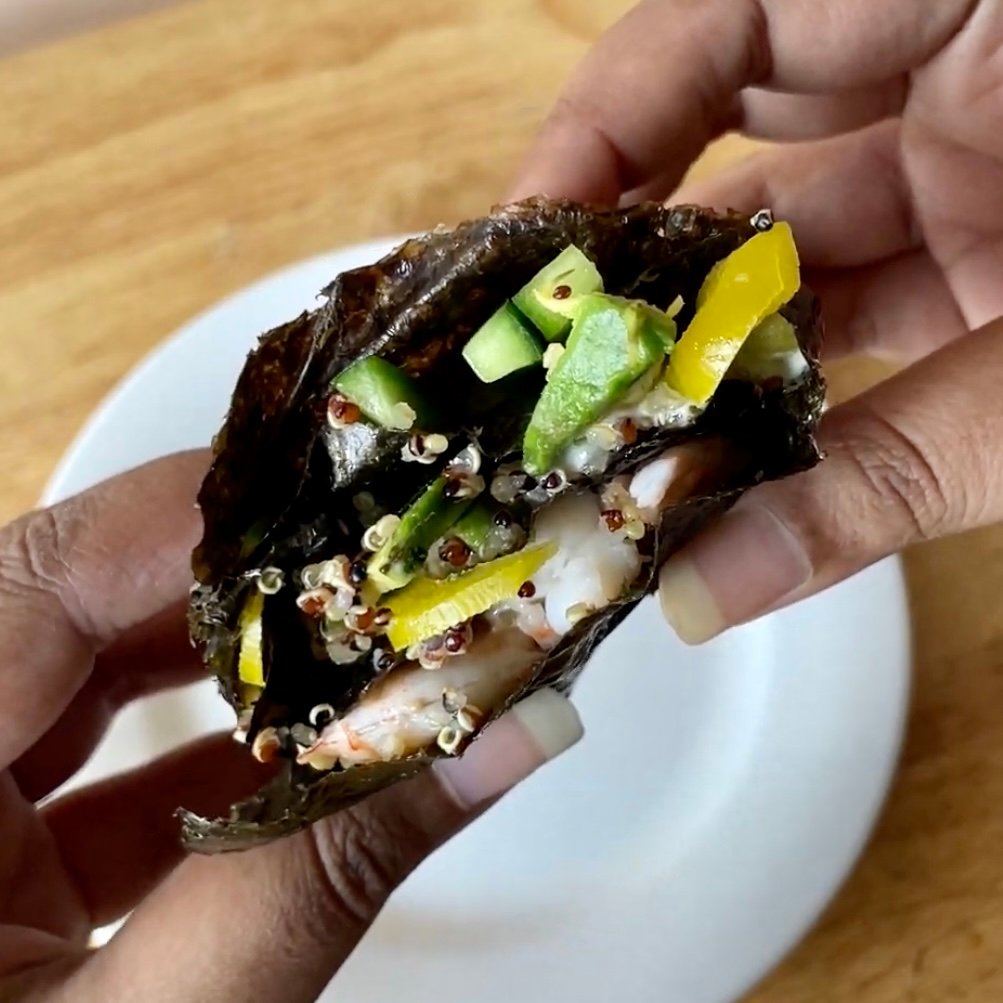
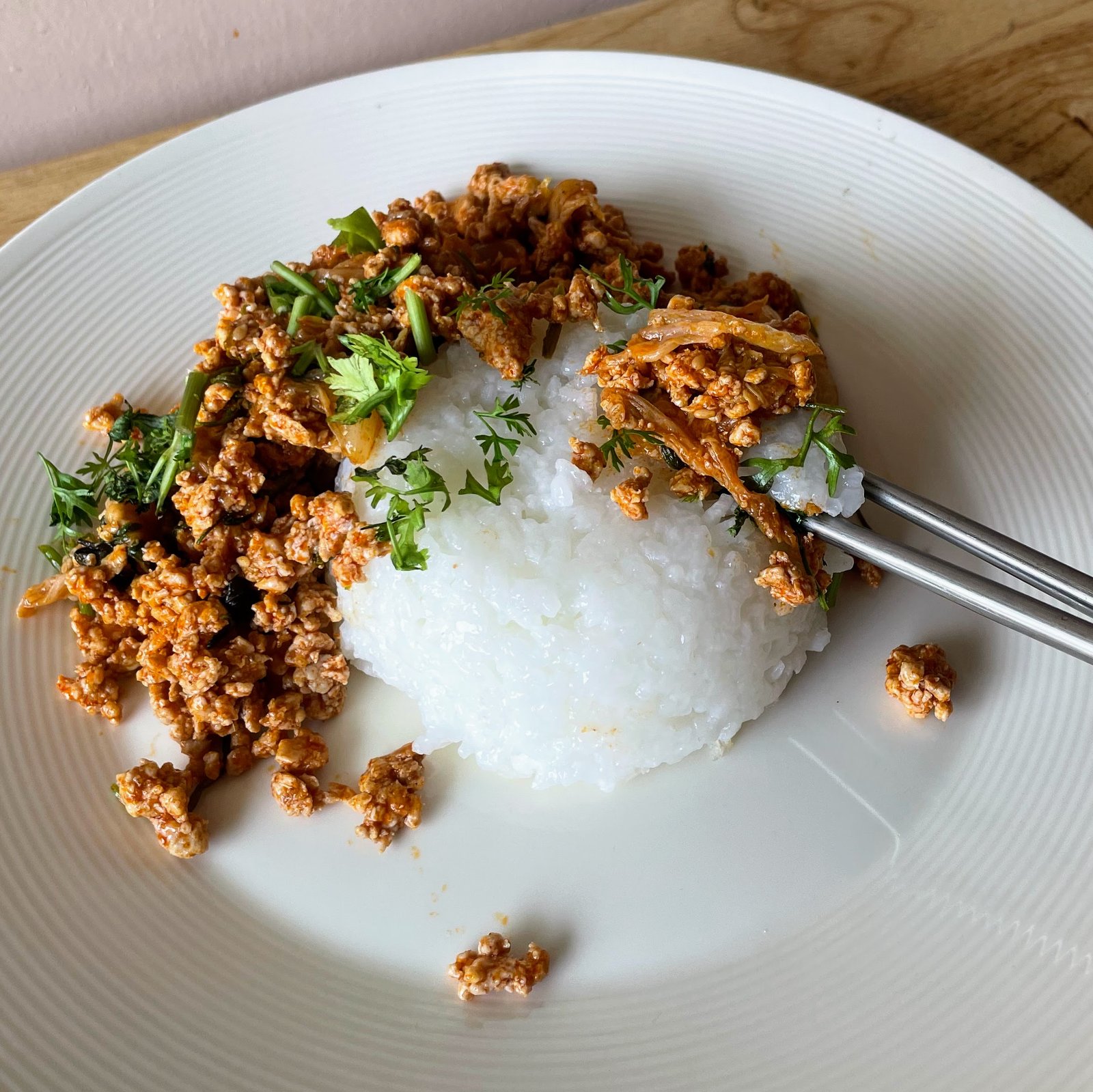
Leave a Reply